Wulai
Another rainy day. Actually not the kind of weather to travel to Wulai in the mountains. But there was no indication that it will change to the better in the next couple of days. So what. I did get already accustomed to this kind of weather. But only the photos will not be as good as shot in the yellow sun and blue skies, so I apologize.
But it was easy to get there in the middle of nature: only 25km south of Taipei. I took the MRT to Xindian, the last stop of the line. The stop for the bus to Wulai was just in front of the station. The ride took 45 minutes for a fare of 1 Euro. Transportation cost altogether was thus 5 Euro (the trip with a tour bus would have cost 30 Euro).
I quickly marched through town (leaving the munchies for later) to get to the mini train station for the 1.6km ride through the jungle and along the river and to the famous waterfall. I could have walked but that I did on my way back.
Click the small picture to get it enlarged
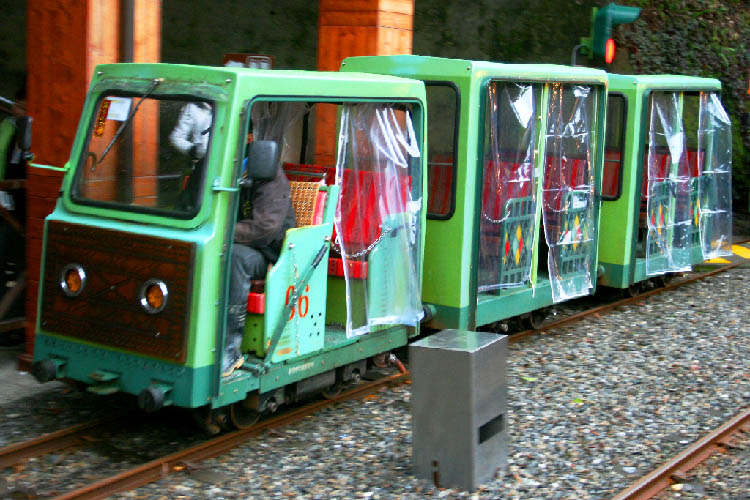
| Mini train today
|
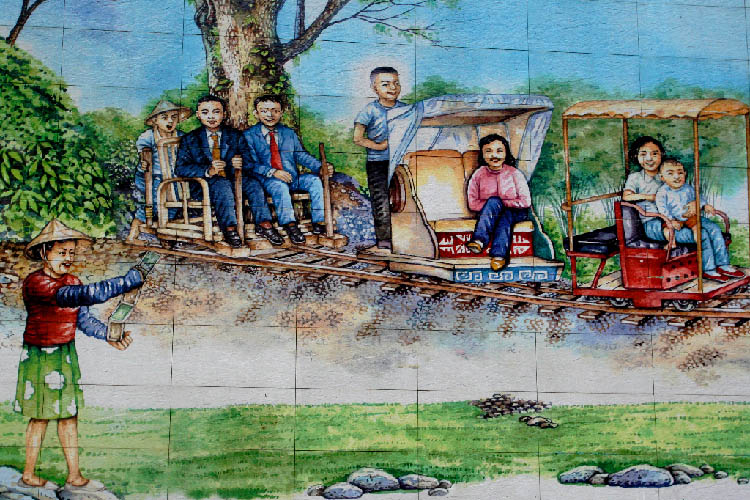
| Mini train yesteryear
|
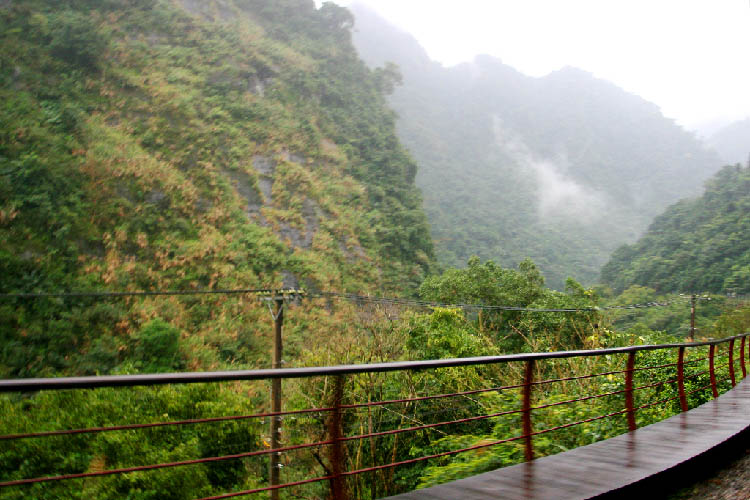
| Misty landscape along the track
|
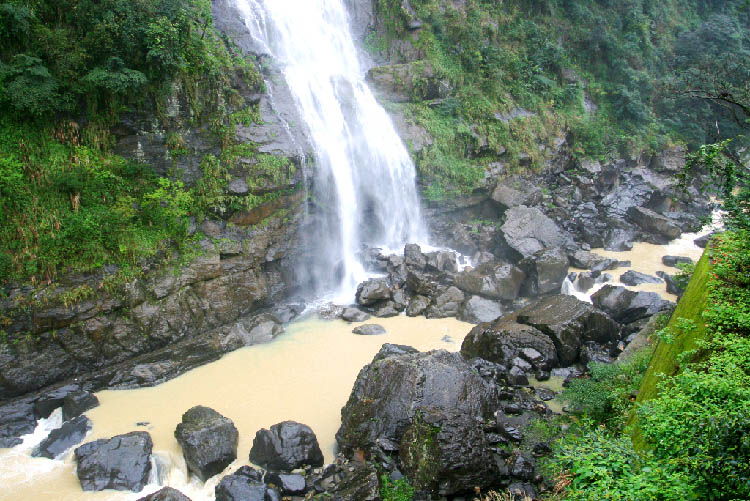
| But more water down the fall
|
The waterfall is 80m high. It's already impressive to look up, but more so to look down. There is a cable car just going over with a nice view, weather permitting, to the waterfall itself but also around the countryside.
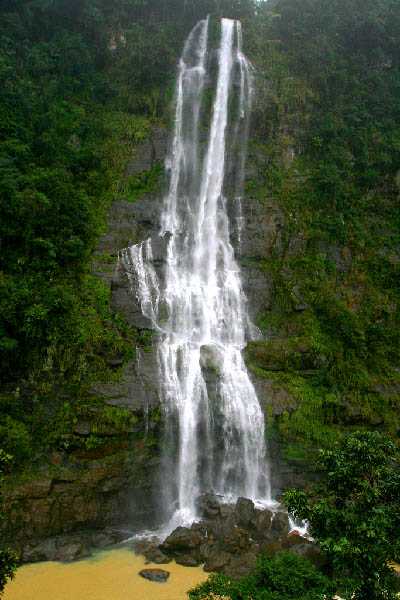
| Looks impressive from below
|
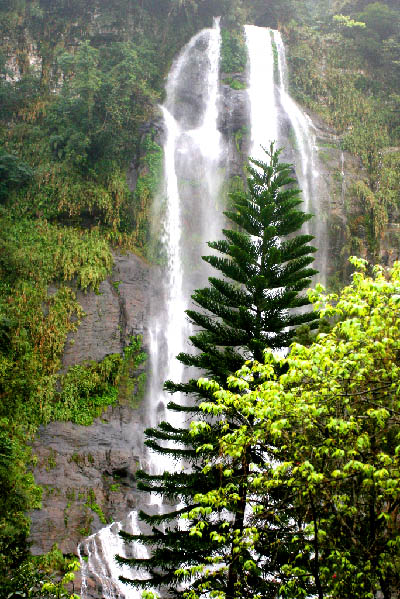
| Also idyllic through the pine tree
|
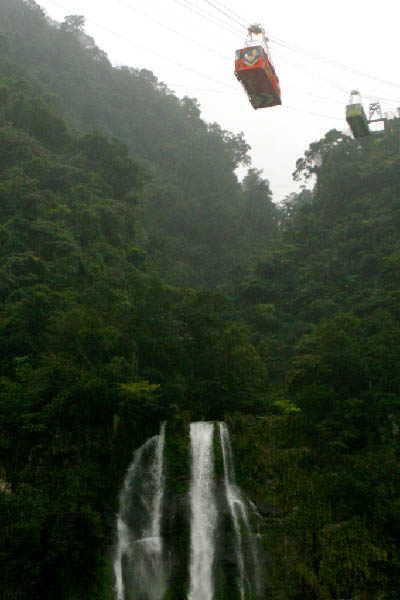
| Here it comes
|
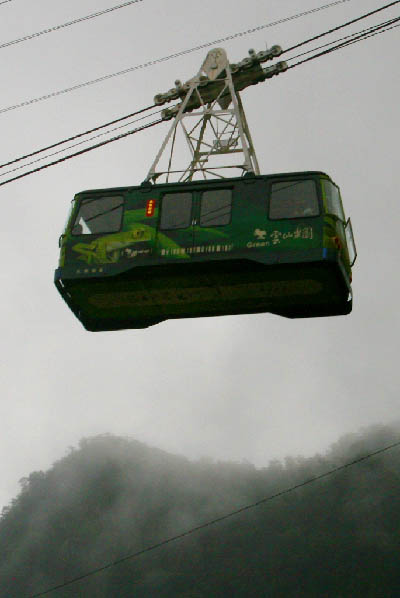
| The cable car
|
There are not only all kinds of transport for the lazy but a lot to do for the energetic: hiking, swimming, scrambling while river tracing, cycling, climbing and rappeling, and bird-watching, though the best time for all that is in summer.
And this is not only a natural retreat for the vacationers and tourists but it was also a "retreat" for aboriginals of the Atayal tribe being pushed into the mountains by the invading Chinese settlers long time ago. The Chinese couldn't care less about their predecessor's culture and customs at that time.
Now, thanks to tourism, there is a revival of the aboriginal heritage ... and big business. The Atayal Tribal Museum just opened a couple of years ago. Harvest and religious festivities are luring tourists from all over the world. I just happened to pass an Aboriginal Folk Dance exercise in front of a first class hotel.
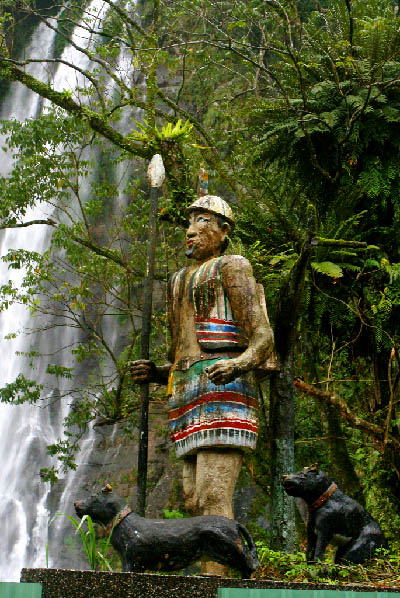
| Proud aboriginal hunter
|
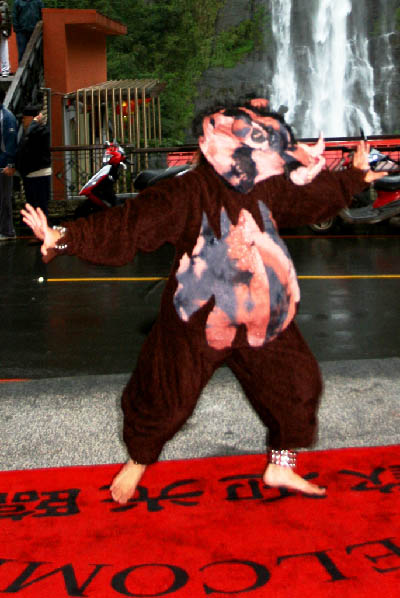
| Funny bunny folk dancer
|
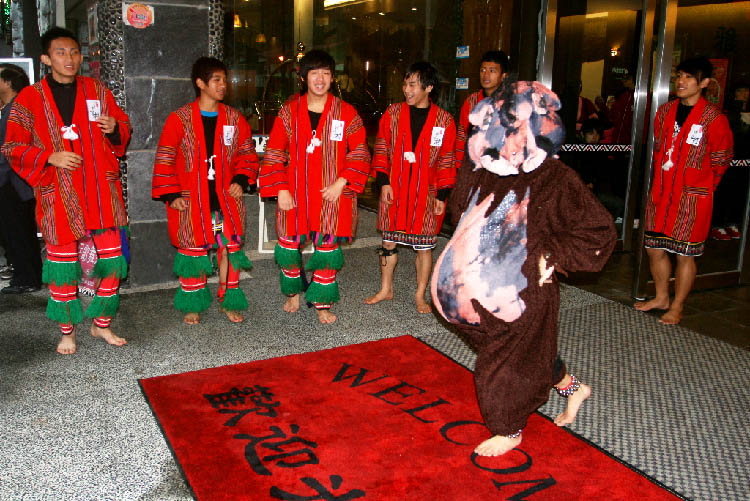
| The folk dance group
|
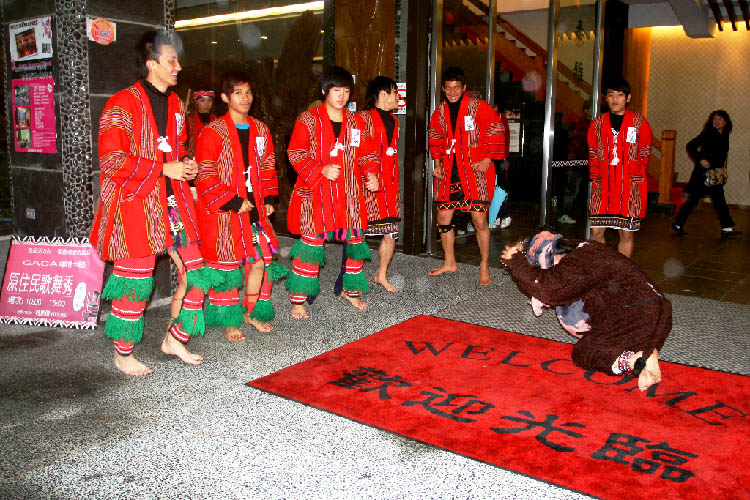
| performing an old play
|
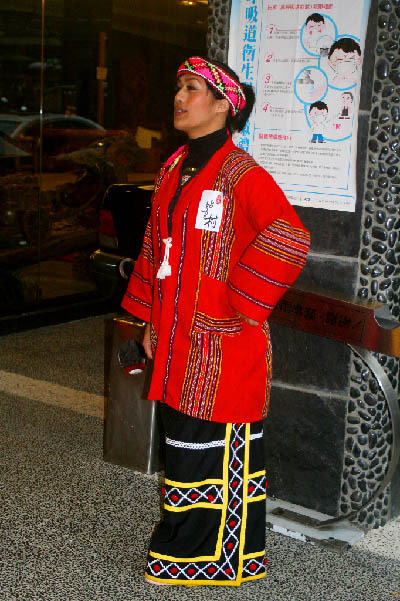
| Singing
|
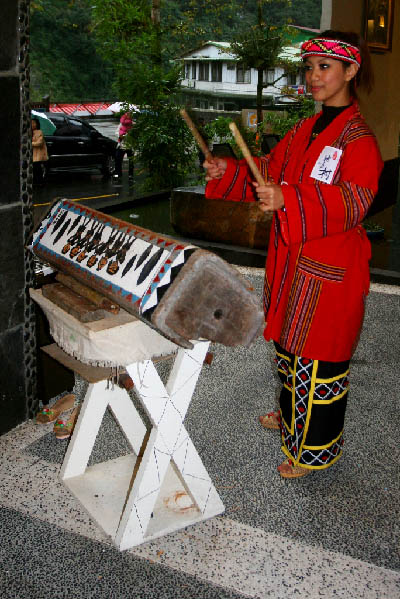
| Drumming
|
There are 13 different aboriginal tribes in Taiwan. The once only inhabitants of Taiwan represent now only around 2% of the overall population.
Not much different from other places, where indigenous peoples have been and still are being "reduced" and pushed back by new settlers (and miners and loggers) from other countries. Some examples: the Ati-Ati in the Philippines by the old Malays, the indigenous tribes of Borneo by Malaysians and Javanese, the Ainu by the Chinese/Japanese, the American Indians by the Europeans, the Avatars on Pandora by the Human Beings, etc, etc.
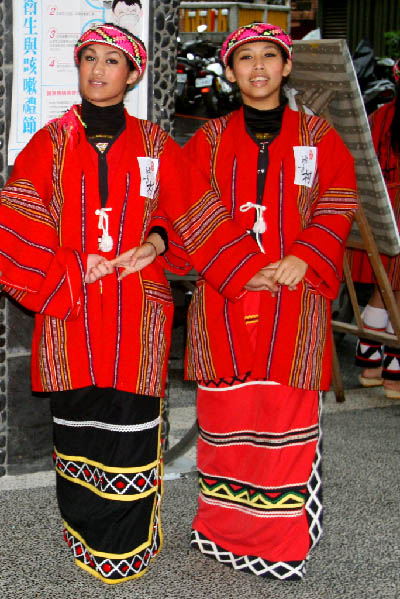
| Beautiful indigenous girls
|
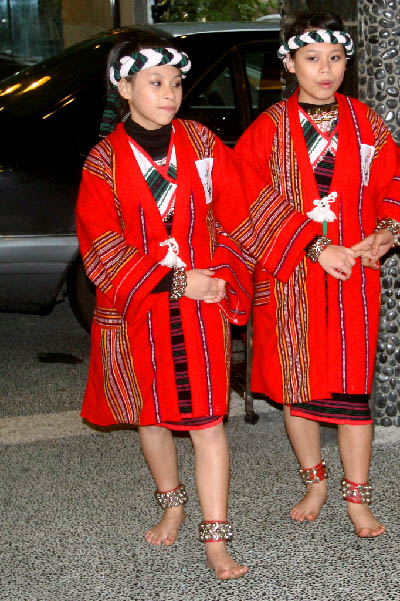
| Are they really aboriginals?
|
Now I have seen enough and skipped the show and had to get back to Wulai town. Maybe next time I may stay in a hotel here around ready for more "energetic" actions. My only action now was walking down the trail between the river and the rail.
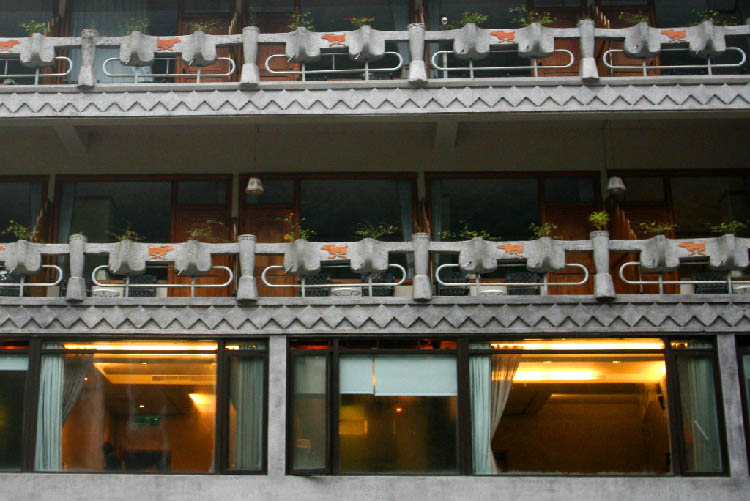
| Shall I stay a night here
|
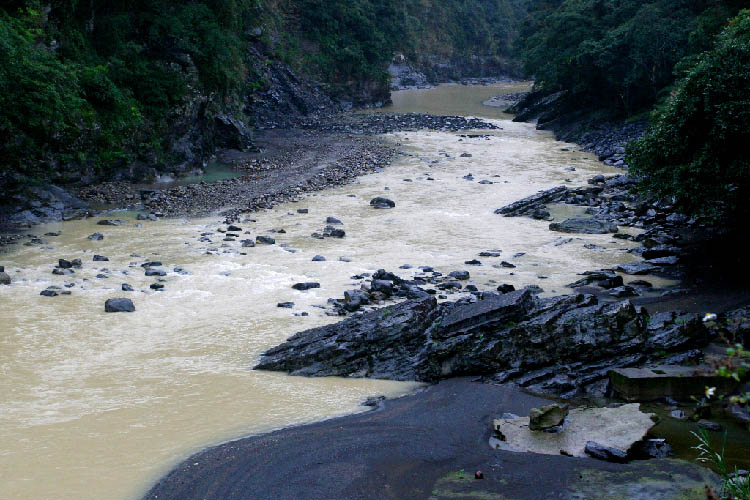
| or walk down to town?
|
Wulai town itself is a Hot Spring Village with many hotels with their own Spa sourced with supposedly pure hot spring water. Though vendors of water heaters have also supposedly made a fortune here.
The hotels are also supposed to be a little grubby, according to the guidebook.
The deliciously roasted pig was also supposedly a wild pig. If you believe it. Chased by the Atayal hunter? Anyway, it tasted good and a drink from the opposite shop washed it down quick.
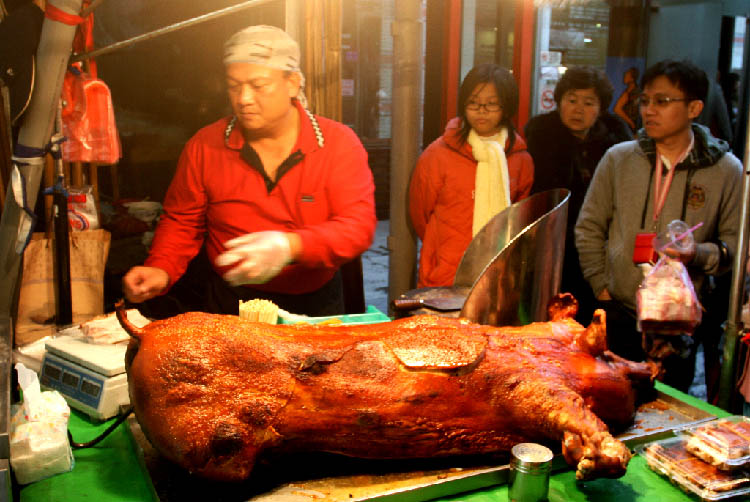
| To eat
|
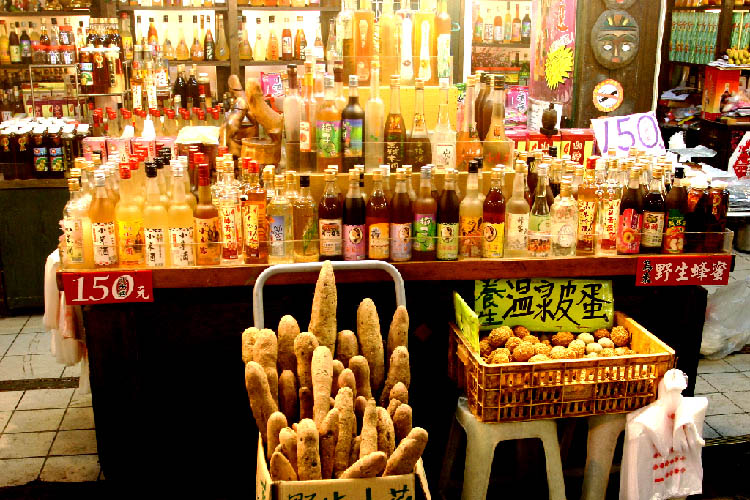
| and drink
|
Then strolling through town and heading to the bus waiting shed where I tried to have a chat with some high school children to test their English speaking capabilities. But that was not much. Their mothers encouraged them to speak more and more but the girls seemed either too shy or didn't know more, because they could only speak a few English words.
I mentioned the English illiteracy of the Taiwanese before, or better the incapability to freely speak English. It is very well know, that the children, not only in Taiwan but more so in China now, are very much pushed by their parents to learn, learn, learn, not so for life but to pass the many examinations, where speech is not emphasized.
One good example: a sales lady in a shop wanted to explain to me how to wash and iron silk clothes but could not say it but was able to write it down in grammatically correct English.
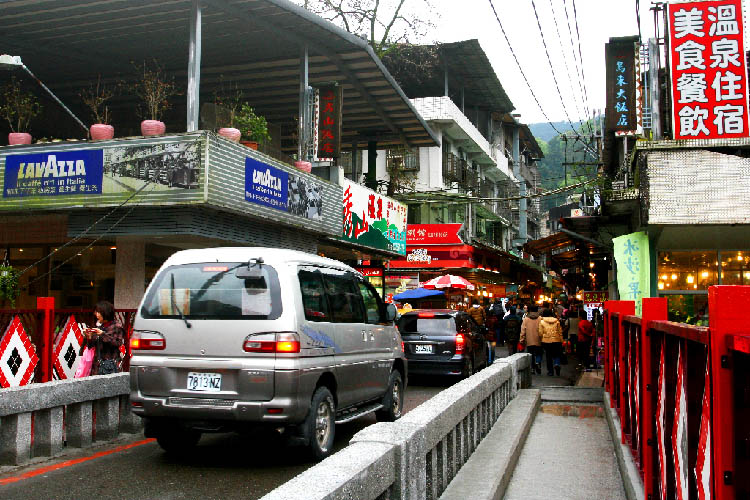
| Old street, modern traffic
|
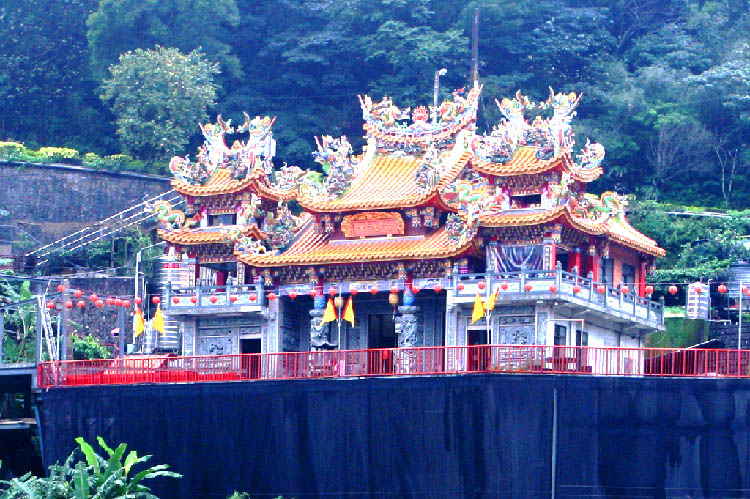
| Old hill with new temple
|
Confucius Temple
Another day, same rain. But this time no wandering around in the countryside but seeking shelter in two famous temples: the Confucius Temple and the Bao-an Temple. Both were closely located in the district of Zhongshan in walking distance from the Yuanshan MRT station.
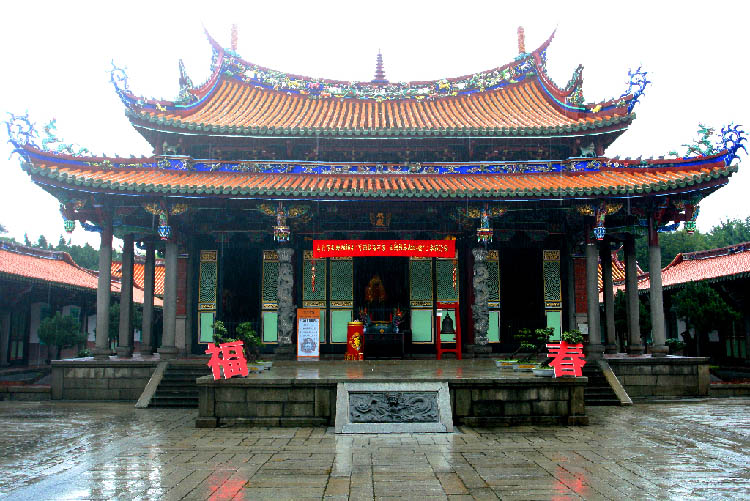
| The Confucius Temple
|
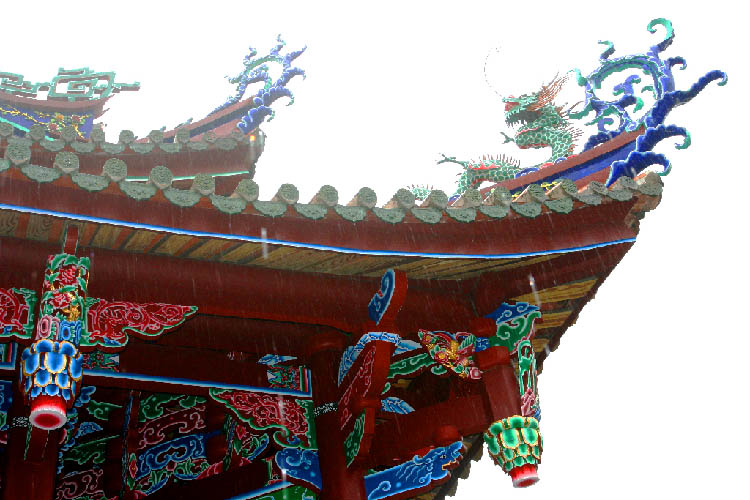
| on a rainy day, again
|
The Confucius Temple is modeled after the temple in Confucius native town, Shandong. Confucius lived around 500BC and was China's greatest educator and scholar, who promoted public learning (not public viewing), i.e. popular education instead of dumbing the people, simplicity instead of pomp (both not like the Catholic Church).
The temple biggest day is celebrated on his birthday September 28. Also a big day for attending celebrities with their entourage, all dressed in elaborate costumes. If you want to attend too, you have to get a ticket five days in advance.
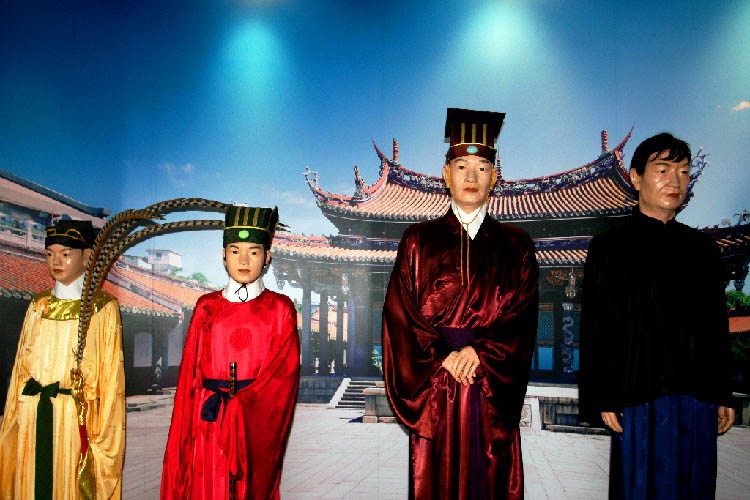
| Inside the temple it was dry
|
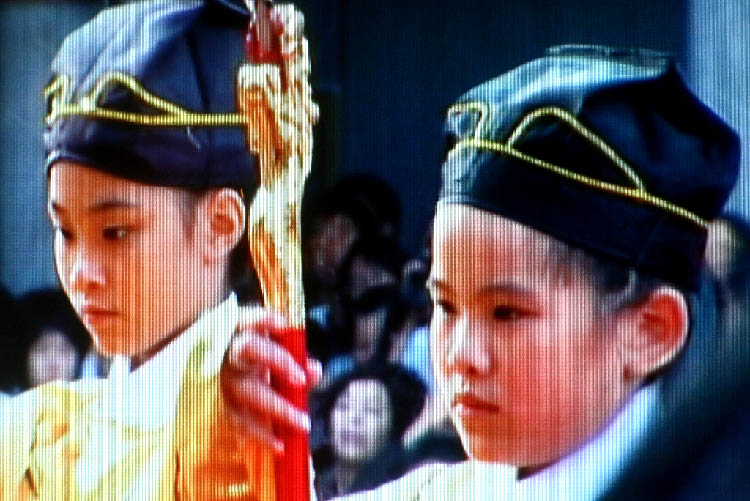
| to look at a celebration display
|
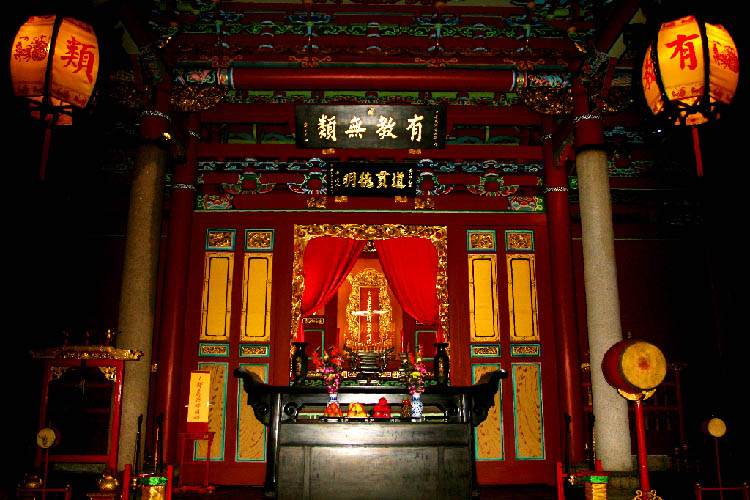
| The Confucius altar
|
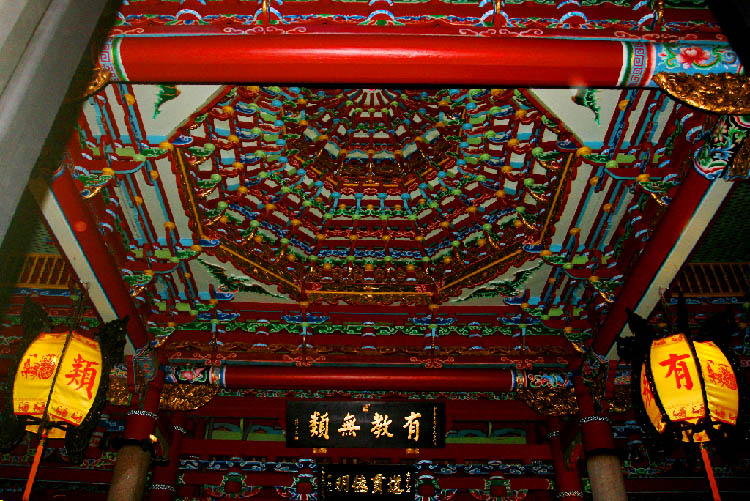
| with the ceiling above
|
The Bao-an Temple
This two hundred years old Bao-an Temple is a Taoist temple and one of the most important religious sites. The most important deity is the emperor Bao-shen, also a famous doctor and great healer. No wonder that this place is frequented by so many visitors to pray for good health, especially today, and here even I had to pray.
But before entering the temple I had to pass the lions first, representing the rule of law and good governance. What a good emperor Bao-shen must have been. He might have been better than any elected president, chancellor or minister (or secretary) of health licking boots of the pharma industry and other lobbyists only to reach a foul compromise to increase the health insurance premiums for our sick society instead of completing a good governance reform of the whole health system.
I suggest to build more of these temples to make the people more health conscious instead of building churches and mosques to teach only love and hate.
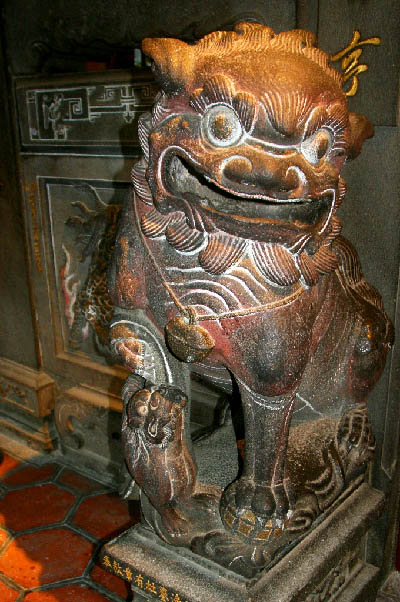
| One lion stands for rule of law
|
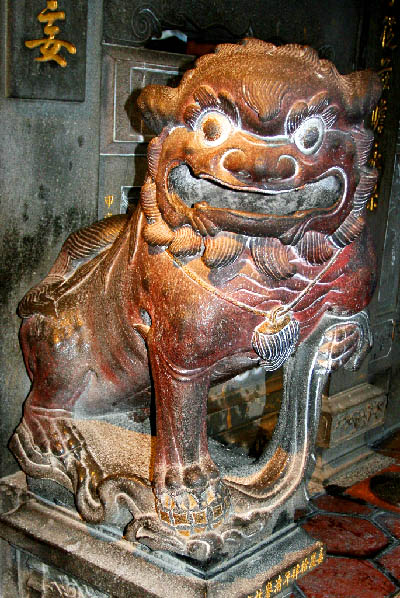
| the other one for good governance
|
The inside of the temple was fantastic. Exotic smell from smoke of the many incense sticks (no anti smoking law prohibits this, yet), the display of the many flower bouquets.
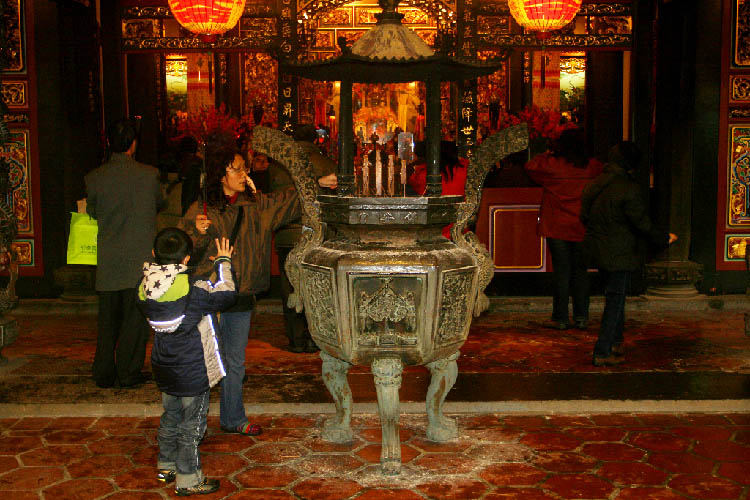
| Incense sticks
|
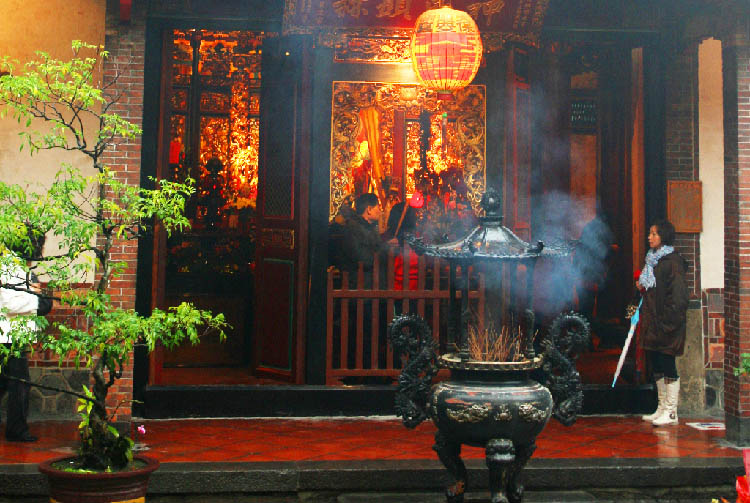
| are already burning
|
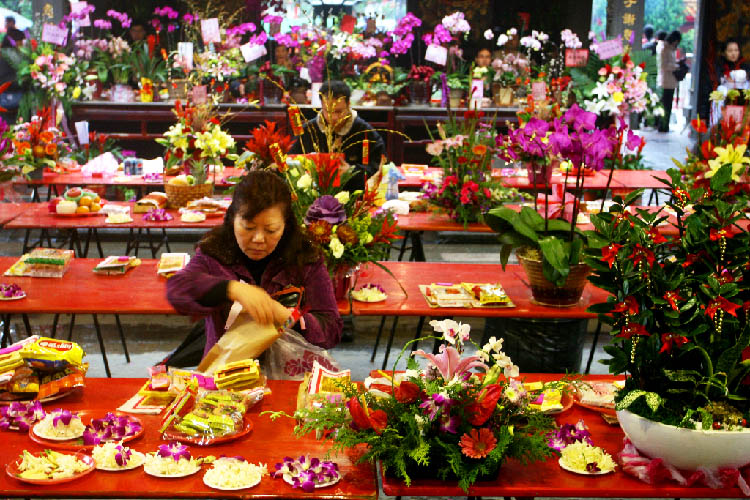
| Flowers all around being offered
|
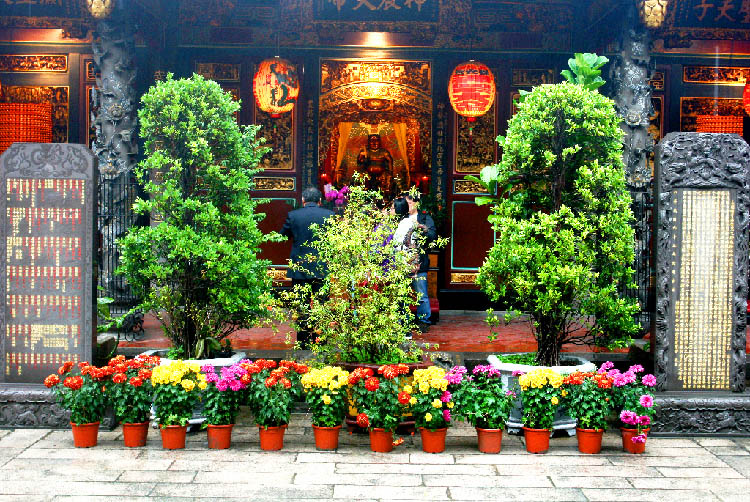
| Also many flower pots and plants
|
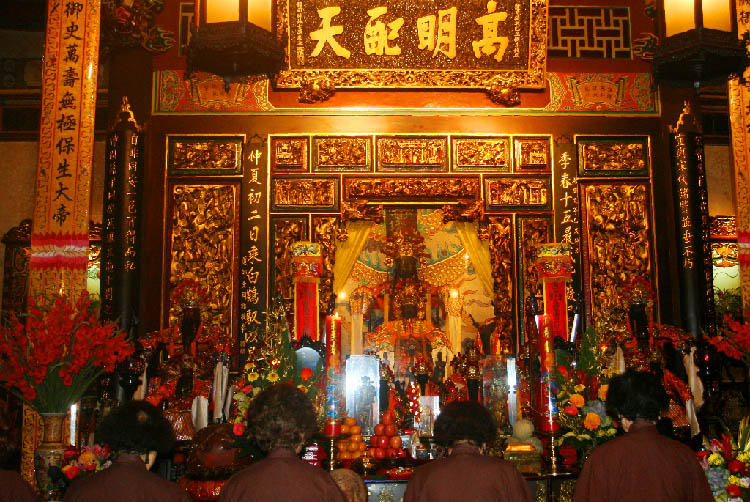
| Nuns are praying
|
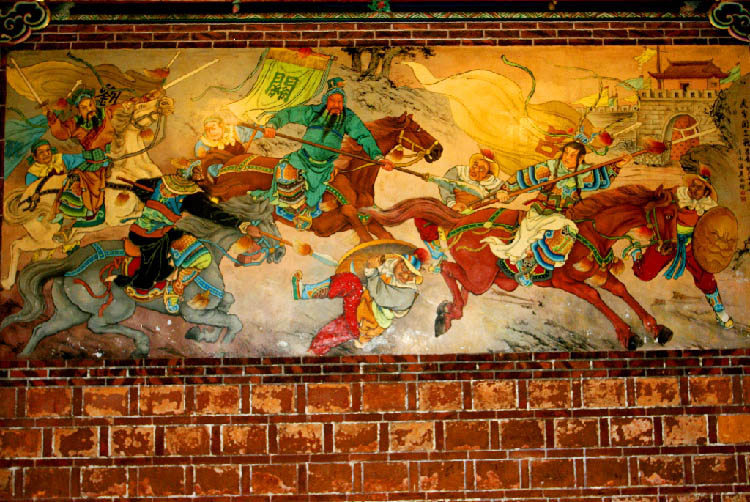
| Paintings all around
|
The paintings all around were very interesting. Life in old China, not much different from today and everywhere. Living healthy but dying in a war. Having a Xanthippe will shorten your life even more. Mobbing and strife does not enhance long life.
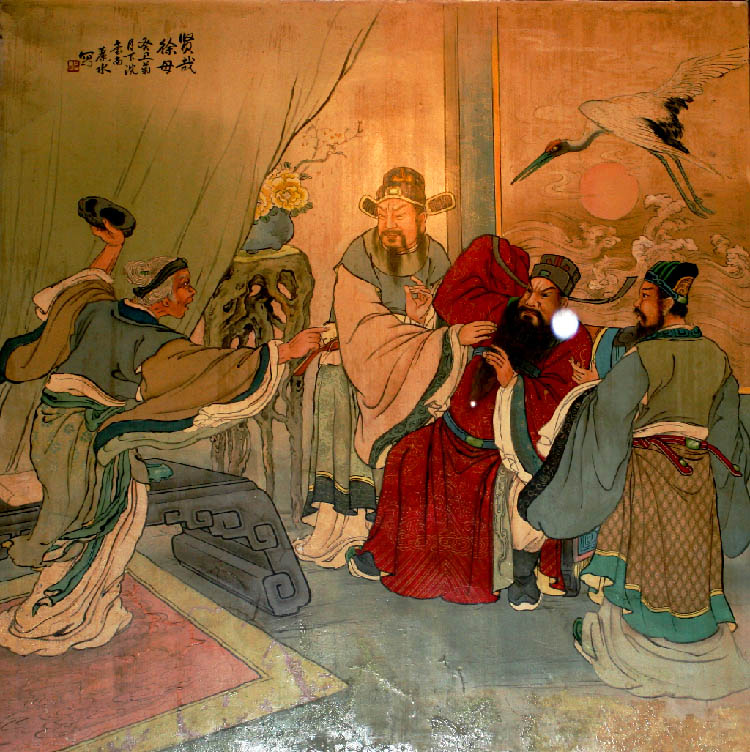
| Depicting life
|
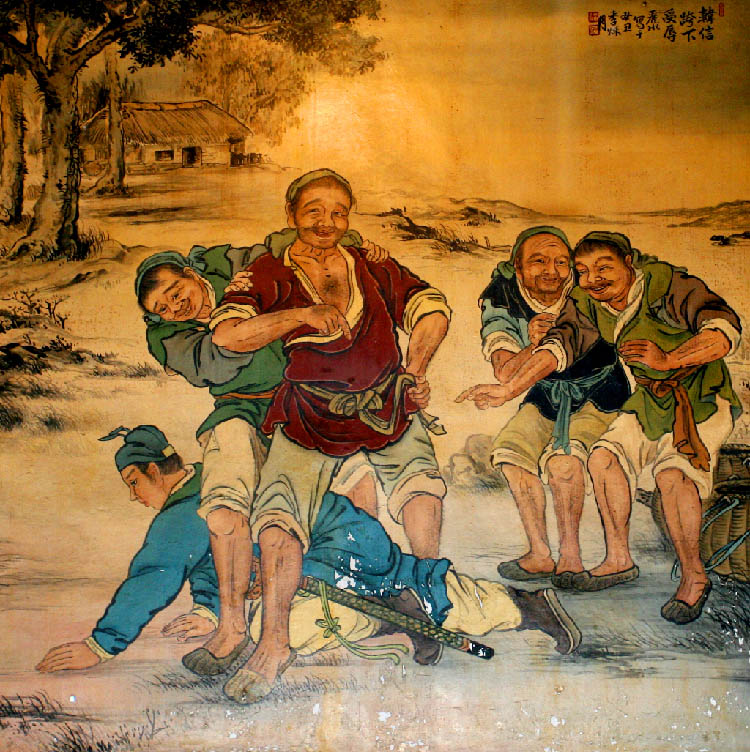
| in old China
|
The temple was also staffed with women and men, besides nuns and monks, being busy with all kinds of tasks. And I had a question to ask about the religious rituals the people were doing all around. A nice lady in a yellow-black anorak gave me a complete tour around the temple while explaining everything in plain English (yes, she can).
First of all I had to get a religious kit for a donation of one Euro, consisting of thirty incense sticks, a package with Lucky Cookies, a Good Health sachet and a bunch of spirit money.
And now I was led around to worship ten deities by burning each time three incense sticks and waving them with both hands three times up and down in front of the altar before finally sticking them into the sand of the brass pot. The Good Health sachet I had to circle above the smoke of the incense sticks three times in order to make the health property inside effective and thus to keep and stay healthy (forever?).
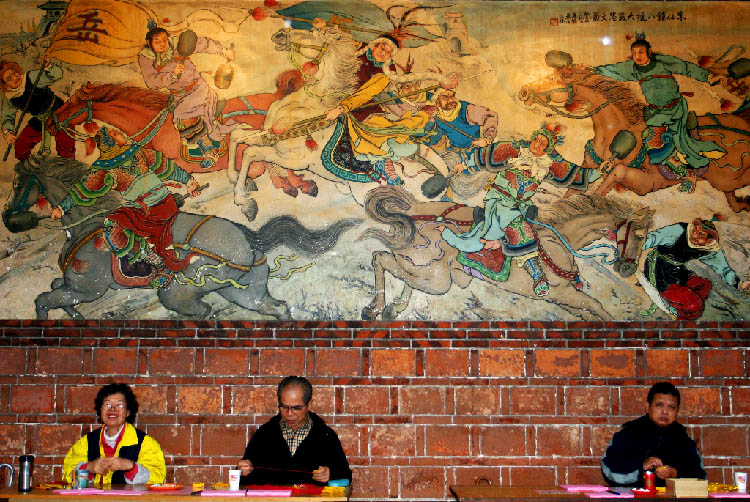
| If you need any help
|
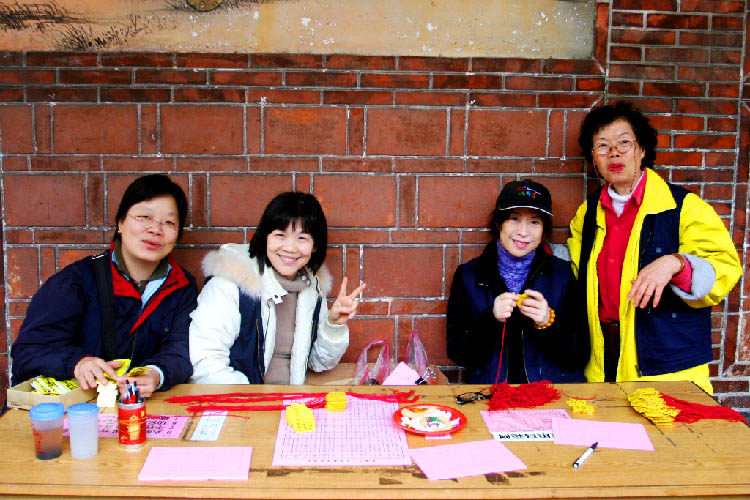
| just ask the friendly staff
|
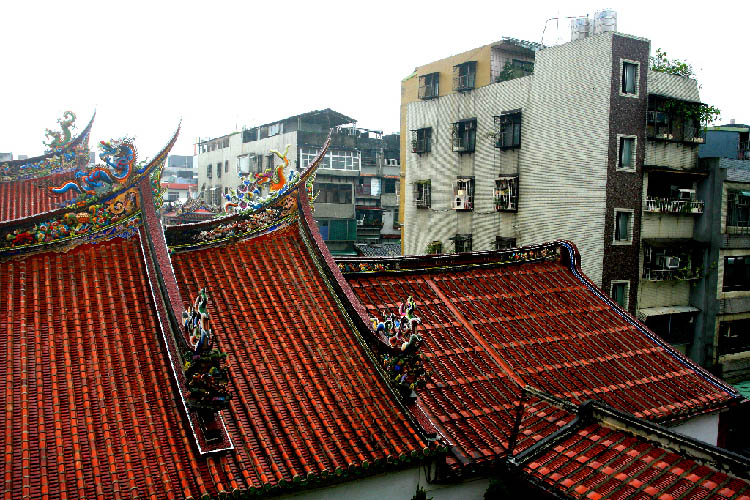
| Looking from the roof to the houses around
|
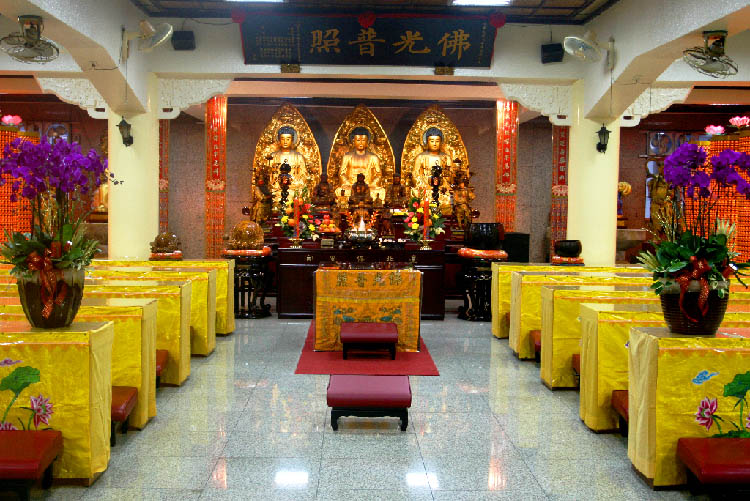
| and into one of the chapels on the upper floor
|
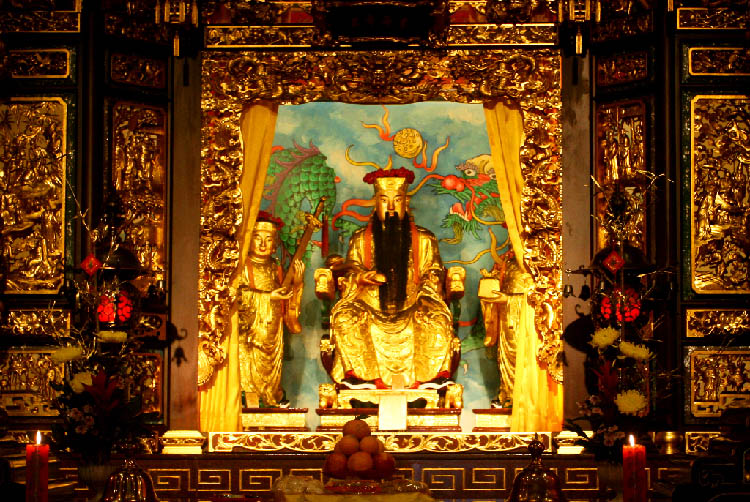
| Paying a visit to all
|
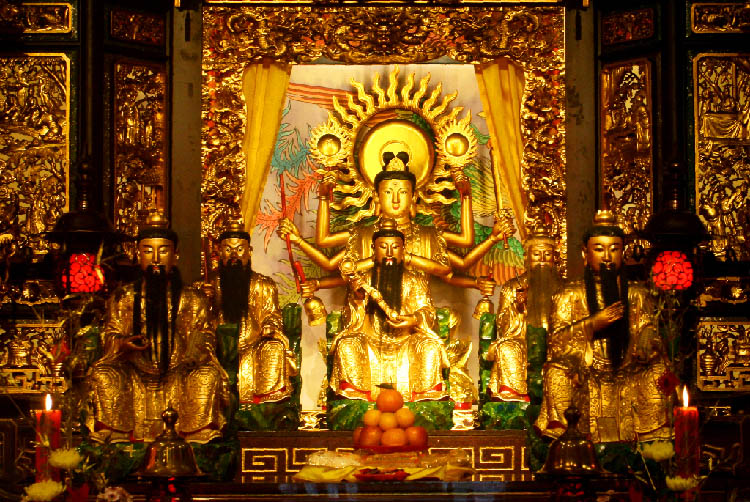
| those many altars
|
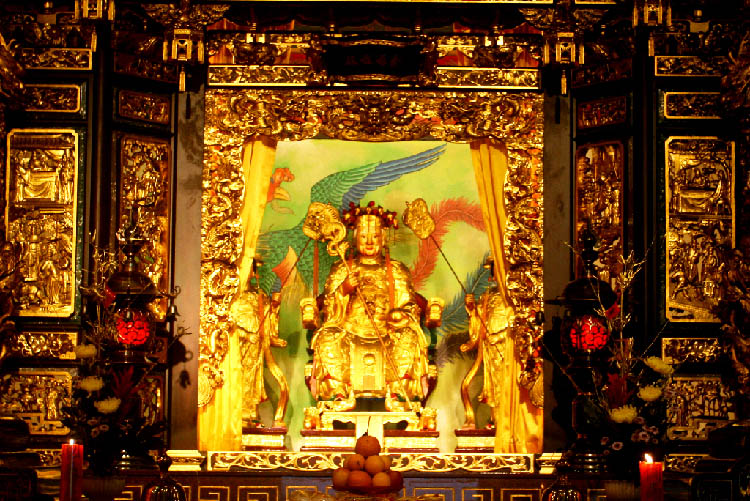
| burning three incense stick
|
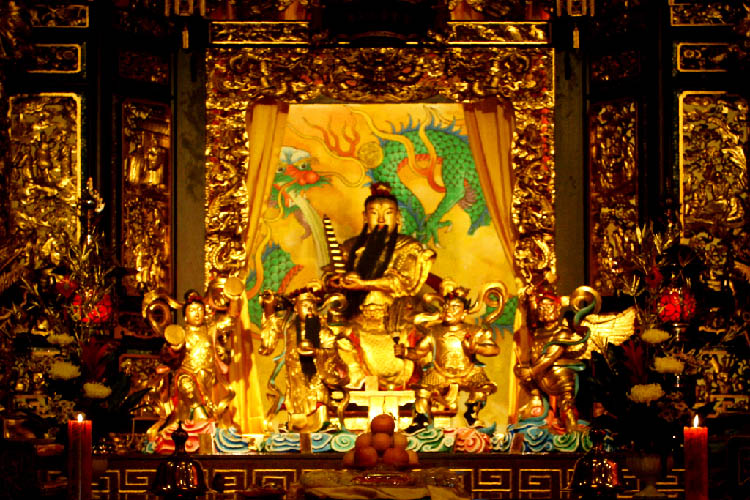
| at each of the gods
|
After having lived devout and almost fasting all day during all those temple visits I will now indulge in a feast orgy I have never experienced before: In a restaurant with the simple name
eatogether
in a mall just a block north of the Taipei Main Station.
I passed that restaurant the day before but it was all full and was told to either wait two hours or come back much earlier next day. What I did and so I was there in the evening at six.
I have not seen such a buffet in all my life (and I have tried many in five stars hotels before). And not just a buffet. You also could order anything you like from any of those many cooks or chefs. That was not only "all you can eat" but eating together with hundreds of other guests (thus the name?), i.e. always full. I ate leisurely for around two hours until I was also completely full. It all was worth the price of 20 Euro.
But if you want to eat really cheap, then at any 7/11 shop you may get any treat, besides some English newspapers to read and that any time of the day, whether a simple breakfast for 1 Euro or lunch or dinner for around 1.50 Euro compiled from the self-service counter.
The Chiang Kai-shek Memorial Hall
Another rainy day. The last day of my stay and time to exercise (to get rid a little bit of my extra pounds acquired on the day before) by walking around a lot first of all in the Chiang Kai-shek Memorial Hall.
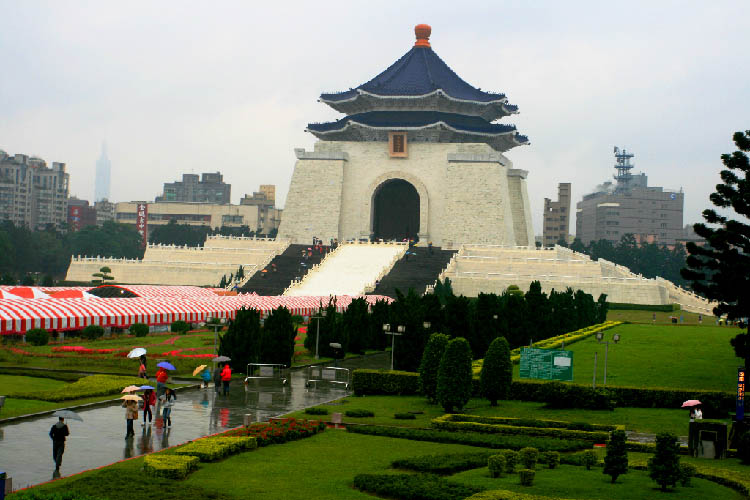
| Chiang Kay-shek
|
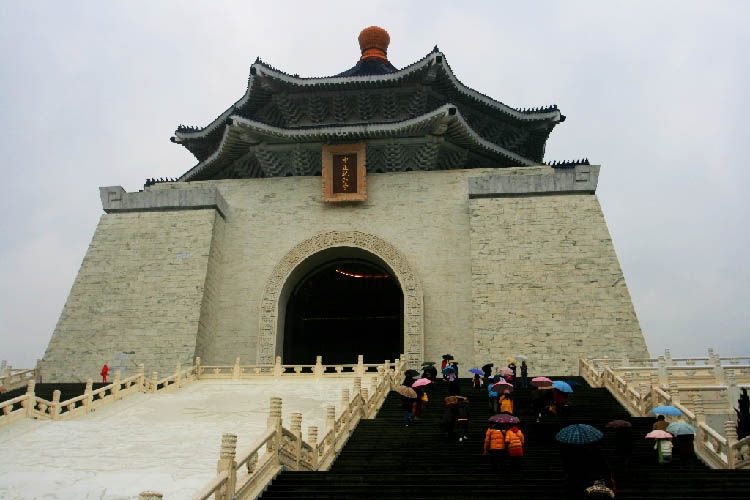
| Memorial Hall
|
Chiang Kai-shek was the leader of China's Nationalist party (after Sun Yat-sen), the Kuomintang (KMT), ruling the Republic of China until defeated by Mao. He fled to Taiwan in 1949 and ruled it until he died in 1975.
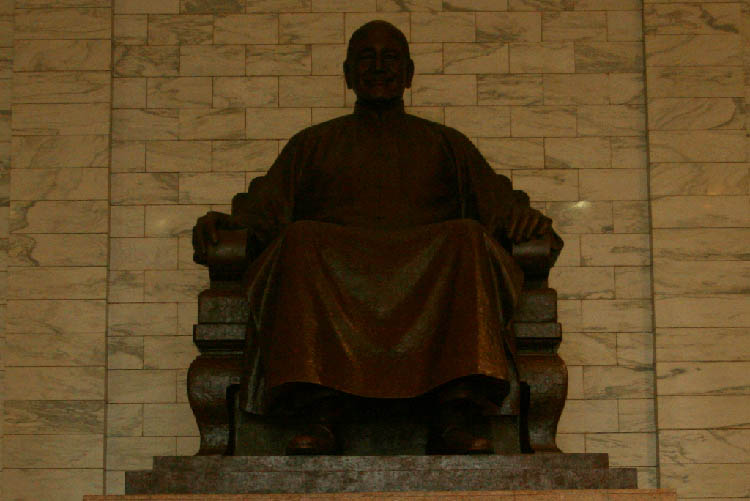
| Sitting like on a throne
|
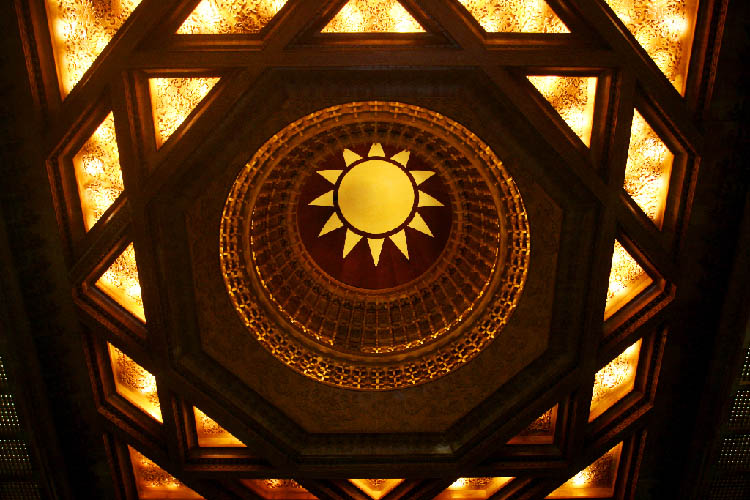
| under a decorative dome
|
This may be the last time you see him in this hall, because most people now want to push Chiang Kai-shek from the throne and rename his hall to the National Taiwan Democracy Monument (the new map I got from the Tourist Office already shows the new name).
Why? Because he ruled with an iron fist and many people now remember this. While he laid the foundation of modern Taiwan he also crushed any political uprising. And there were a lot and there is a lot more to tell about it. Just look up history books or the internet if you want to know more.
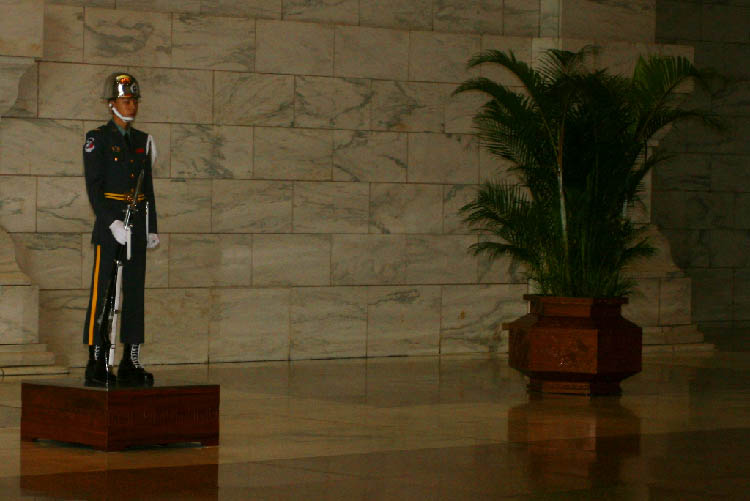
| Flanked by soldiers
|
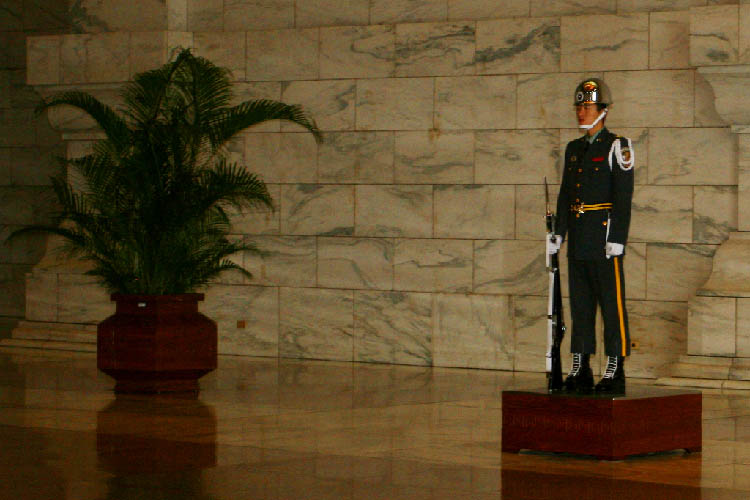
| on the left and right
|
Some day the changing of the guard will probably be changed to honor the democracy instead. It would be a pity if they want to cease it. Maybe not so for the soldiers standing still motionless. I do not know how they do it. Marching impeccable is learnable but how they can ignore and stand any itchings without scratching. I can't.
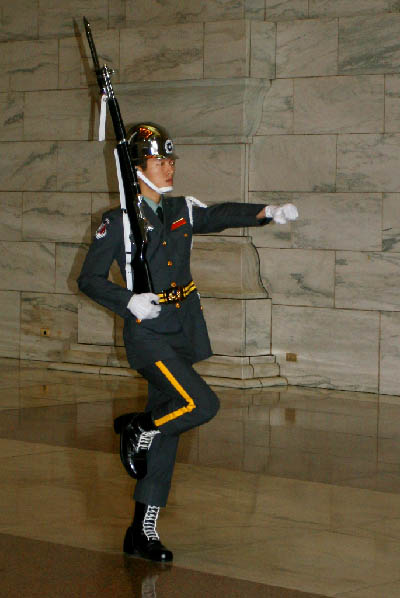
| Changing
|
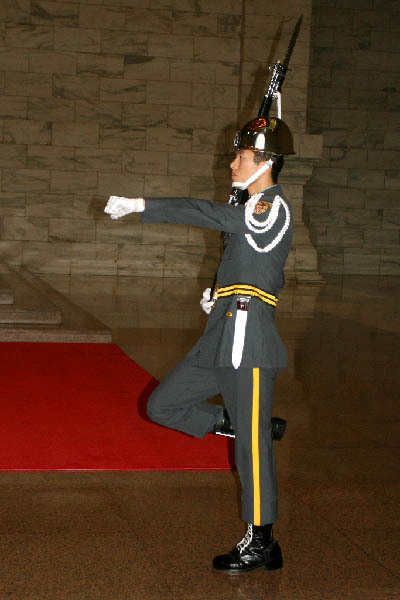
| the guard
|
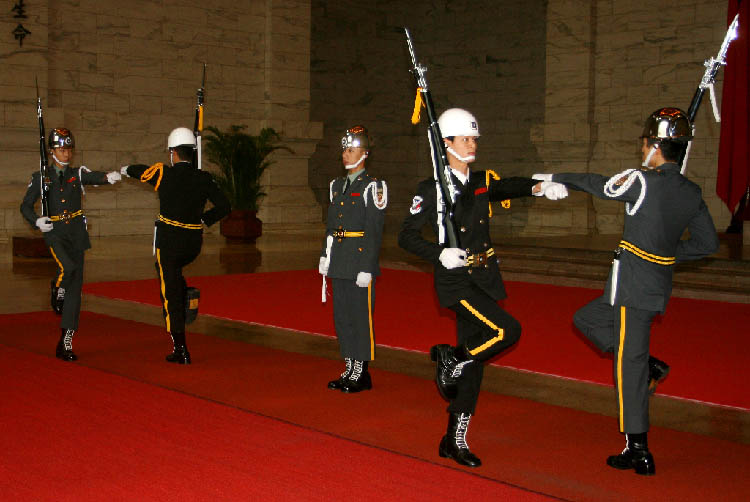
| White helmets
|
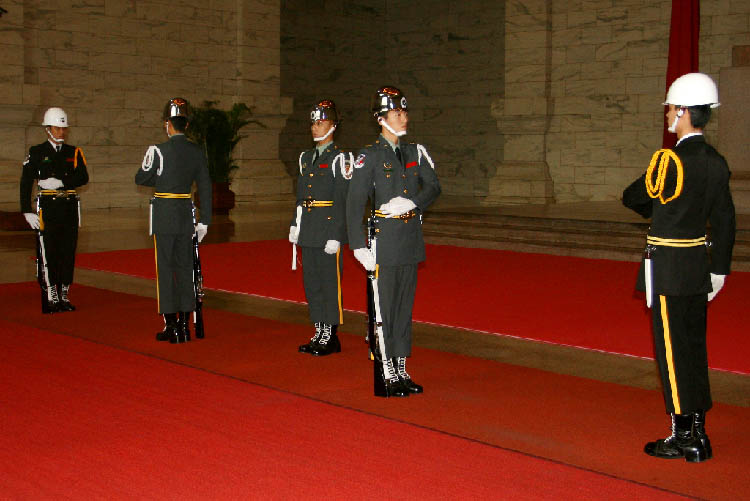
| take over
|
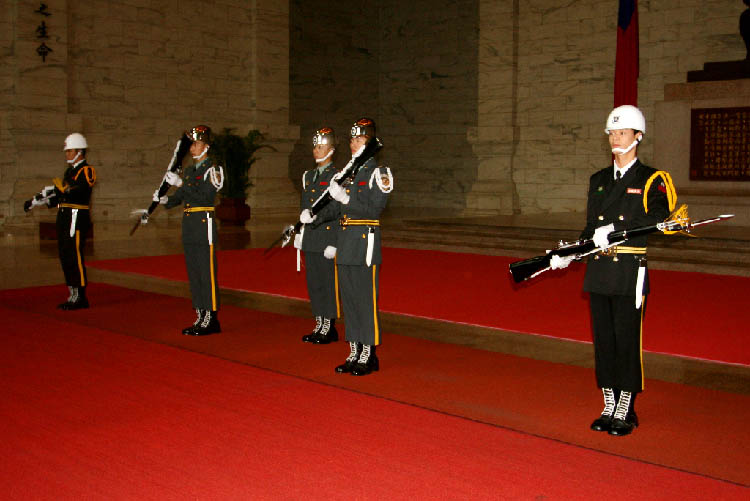
| Swirling the rifles
|
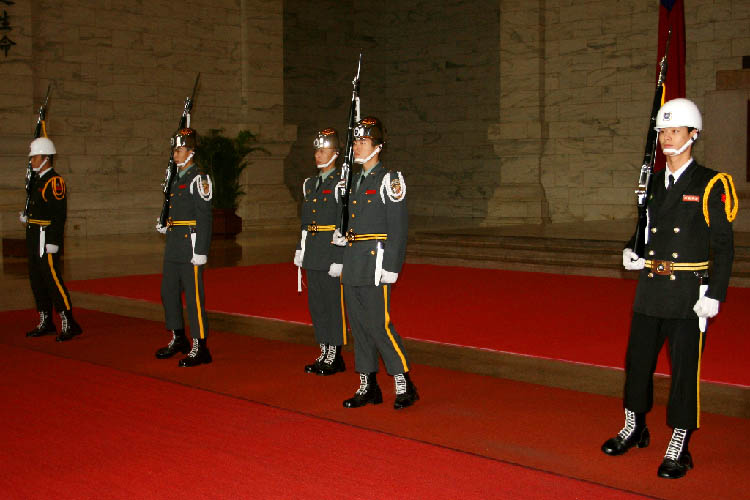
| Ready to leave
|
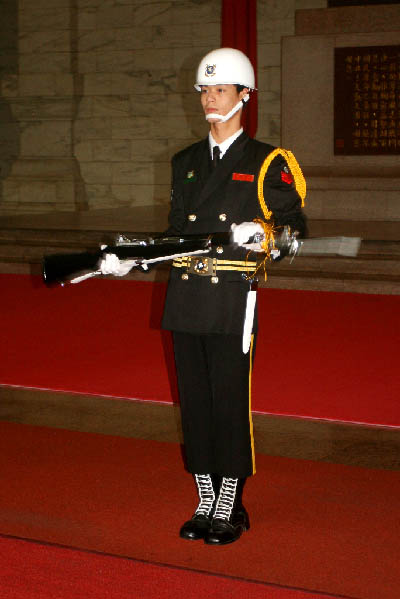
| Presenting the rifle with respect
|
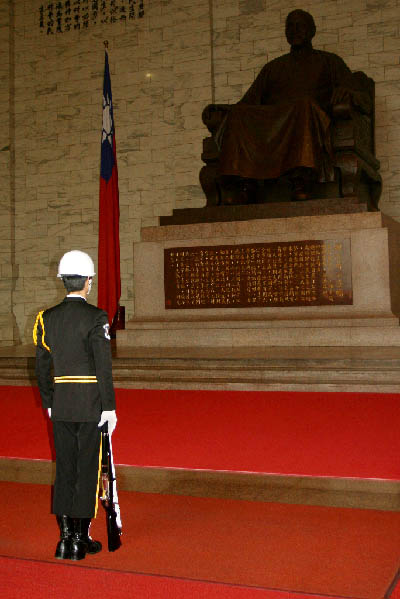
| to the late Chiang Kai-shek
|
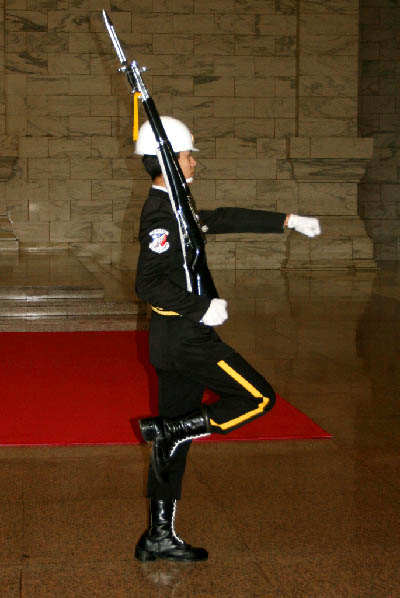
| Take up your post
|
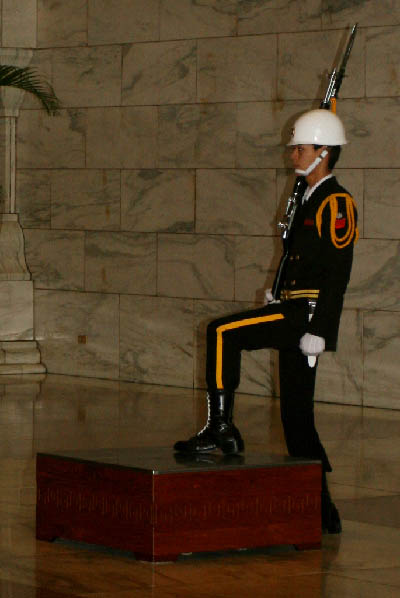
| and stand still
|
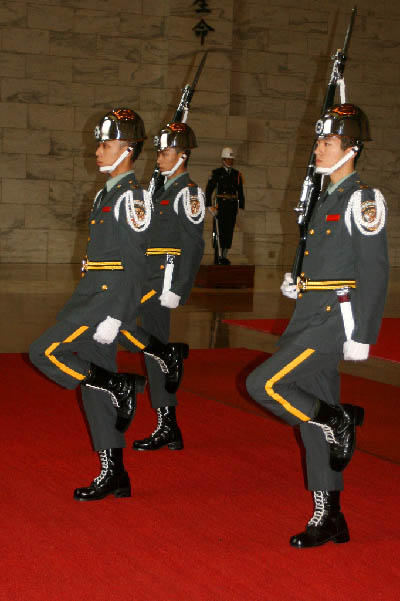
| Old guard leave the same
|
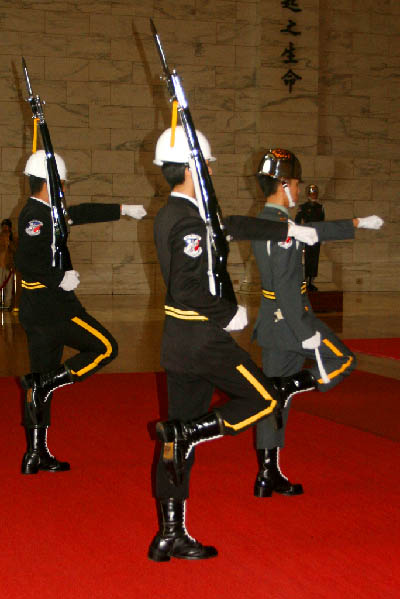
| as the new have come
|
There is also a museum in the same building solely dedicated to Chiang Kai-shek and his time. No need to eradicate this like pushing him from the throne, because he is still an important part of Taiwanese history, even if the many descriptions on display show him in a more favorable light.
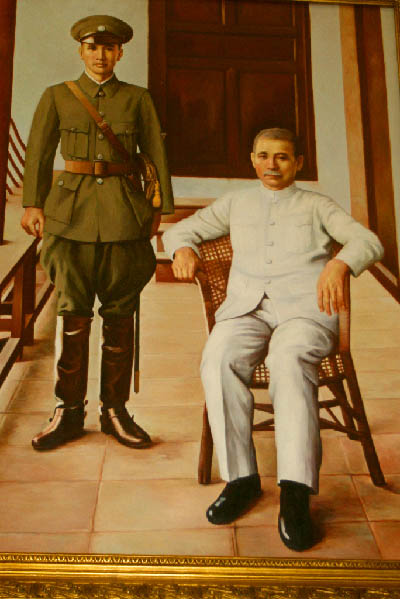
| Chiang Kai-shek with old Sun Yat-sen
|
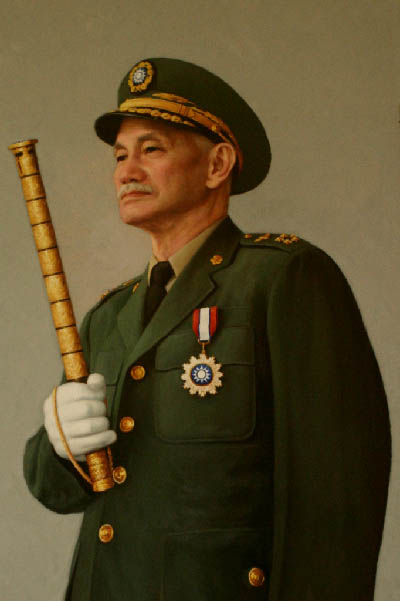
| Here with a scepter ruling like a king
|
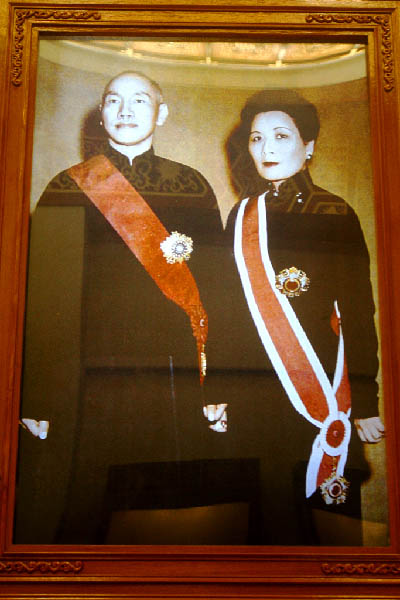
| Chiang Kai-shek with his wife
|
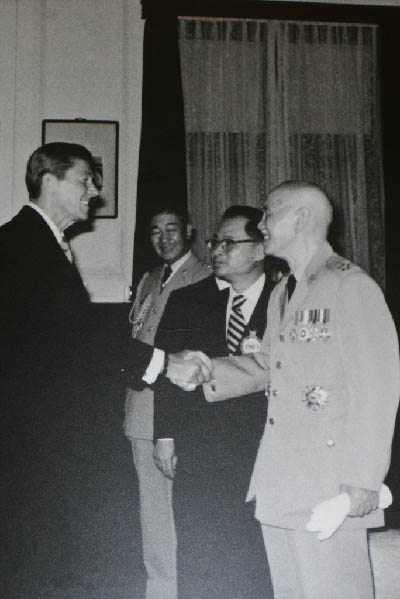
| and with the president Reagan
|
Chang's old original office is on display with him sitting behind his desk but modeled in wax. No problem to keep him here even if he is being disgraced a bit. Though, he was still a better guy than Mao. I wonder what would have become of Mainland China now if Chang would have been victorious over the Communists. At least religious freedom would not have been suppressed. So maybe that is the reason some Buddhist monks also pay him respect or it is just interest in history.
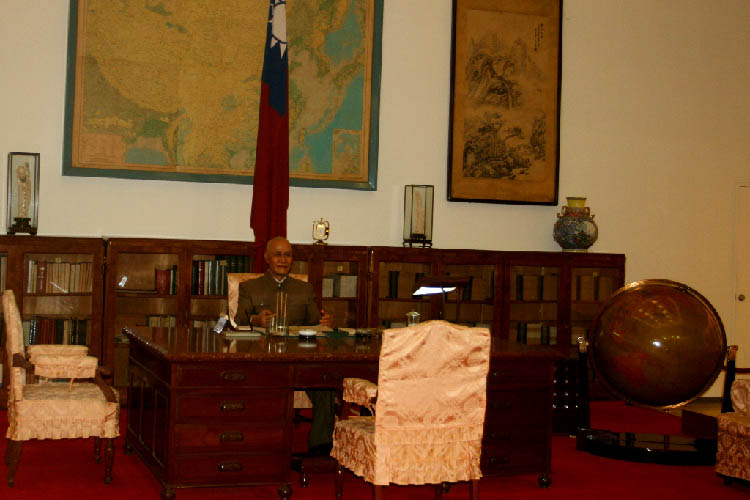
| His old office
|
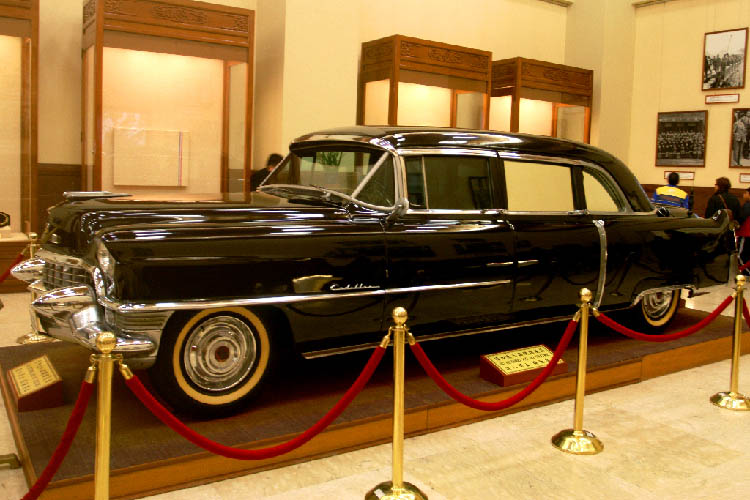
| His old Cadillac
|
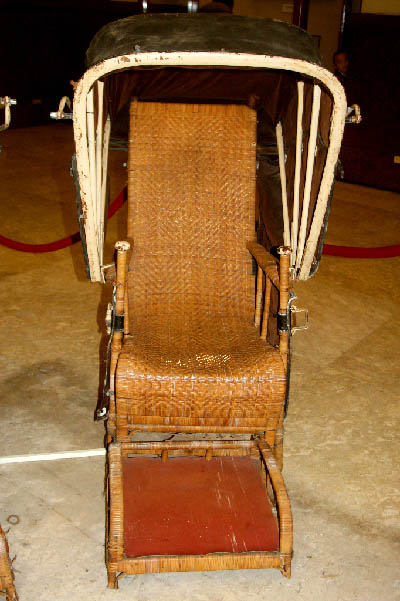
| His old Rikshaw
|
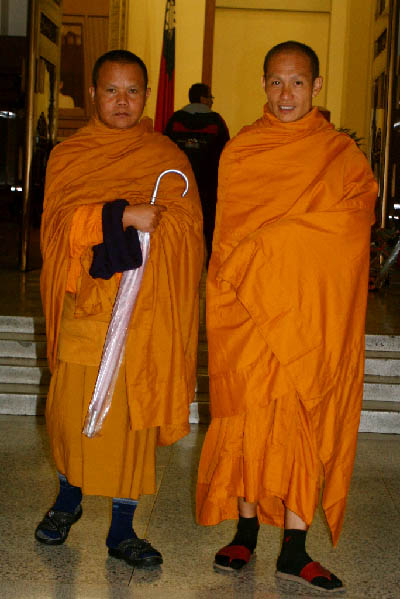
| Visiting young monks
|
The Chiang Kai-shek Memorial Hall not only houses a museum but also many galleries, one of them just exhibited Chinese paintings.
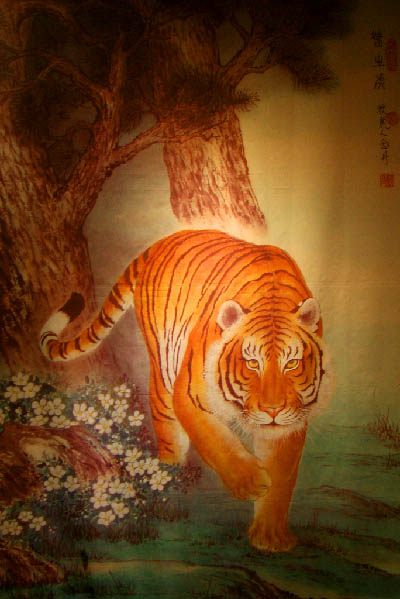
| Interesting painting exhibition
|
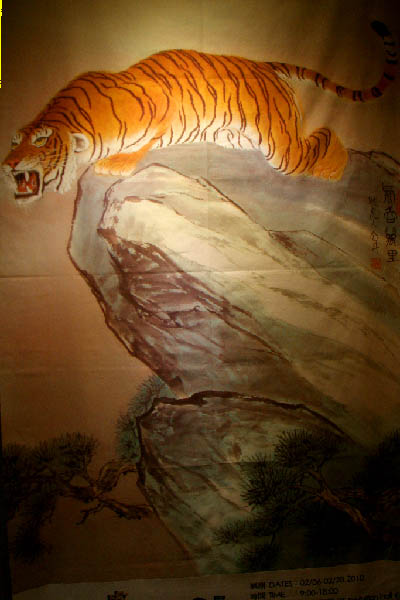
| In the Chiang Kai-shek Memorial Hall
|
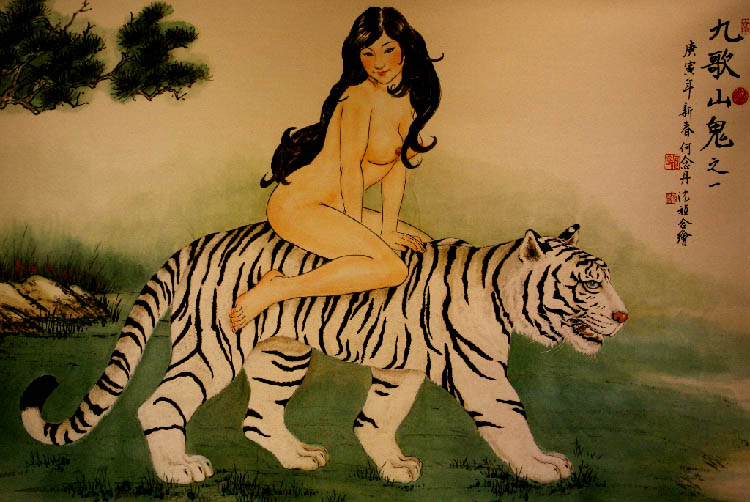
| Because of
|
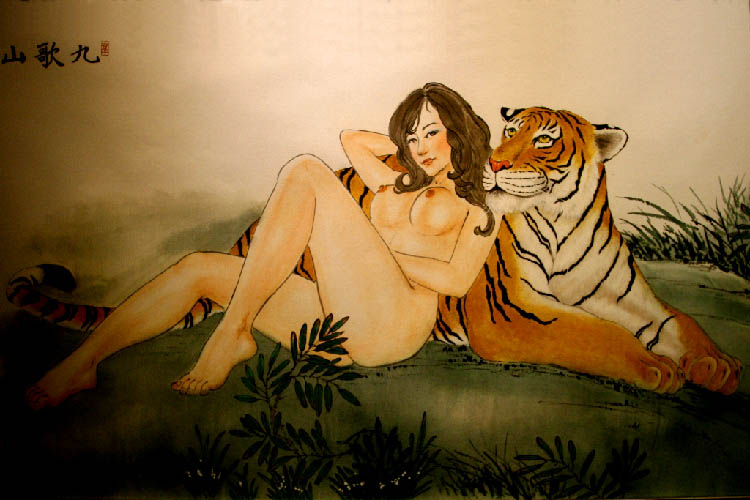
| the year of the tiger
|
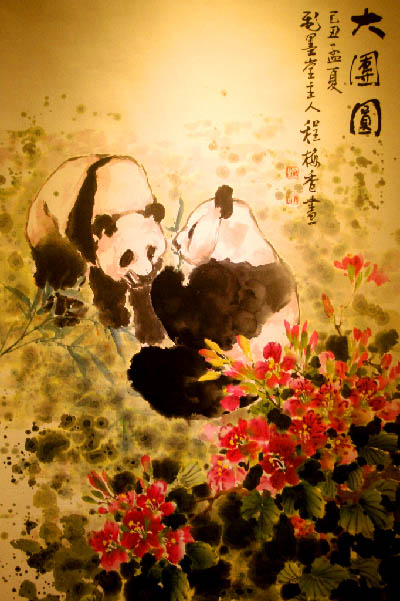
| But not to miss the Pandas
|
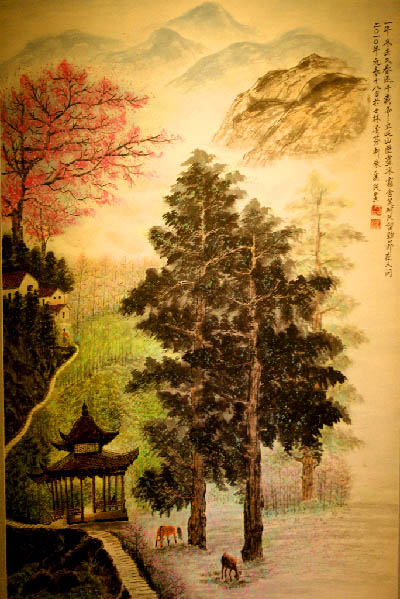
| and typical Chinese landscapes
|
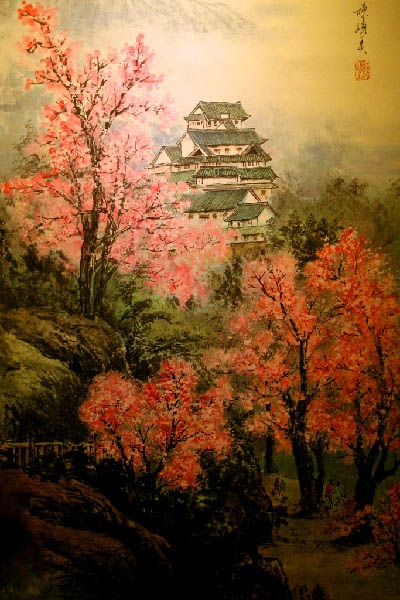
| With mountains
|
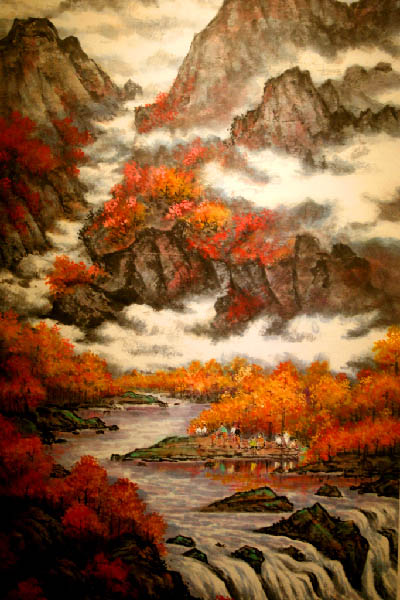
| and rivers
|
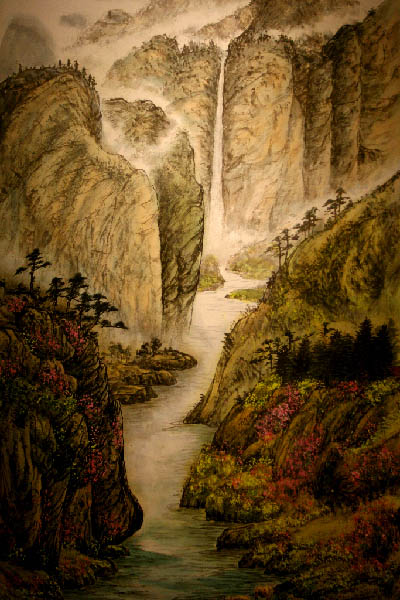
| With canyons
|
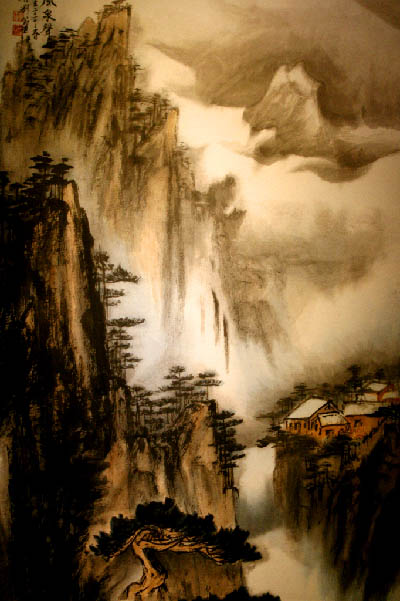
| and gorges
|
Another exhibition was the "Fishes Dancing with Lotus" woodcarvings by Huang Ma Ching. Take a look yourself at these finely chiseled workmanship.
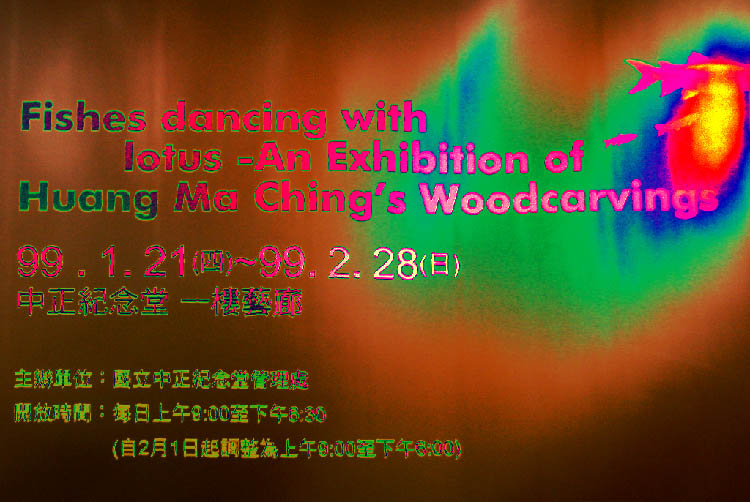
| Another interesting exhibition
|
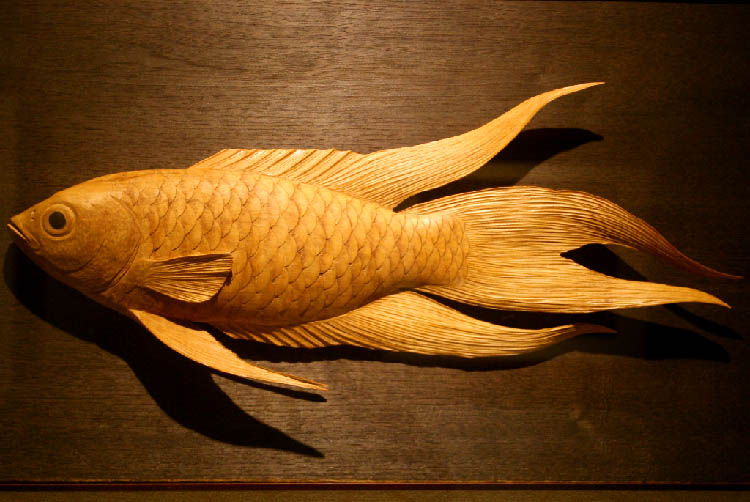
| Woodcarvings
|
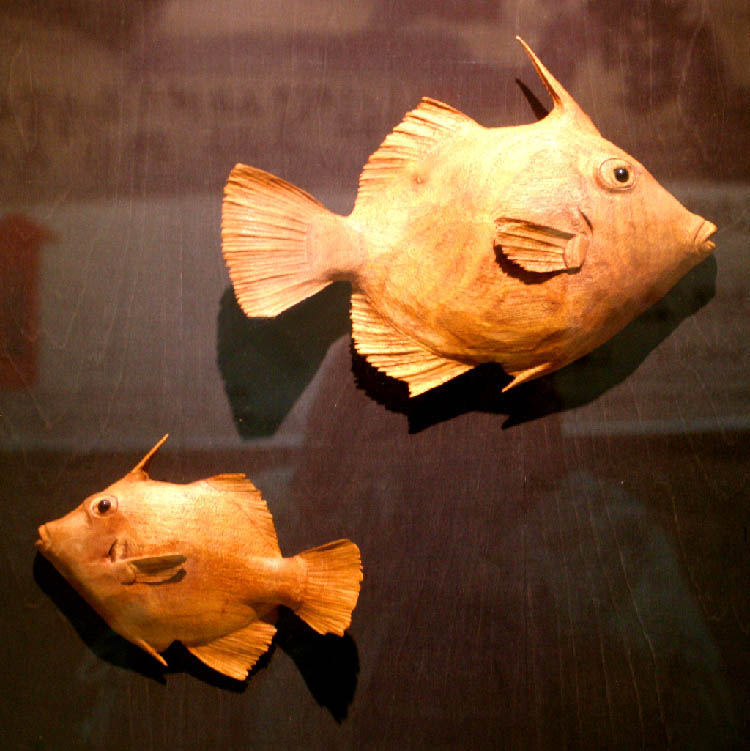
| Fish
|
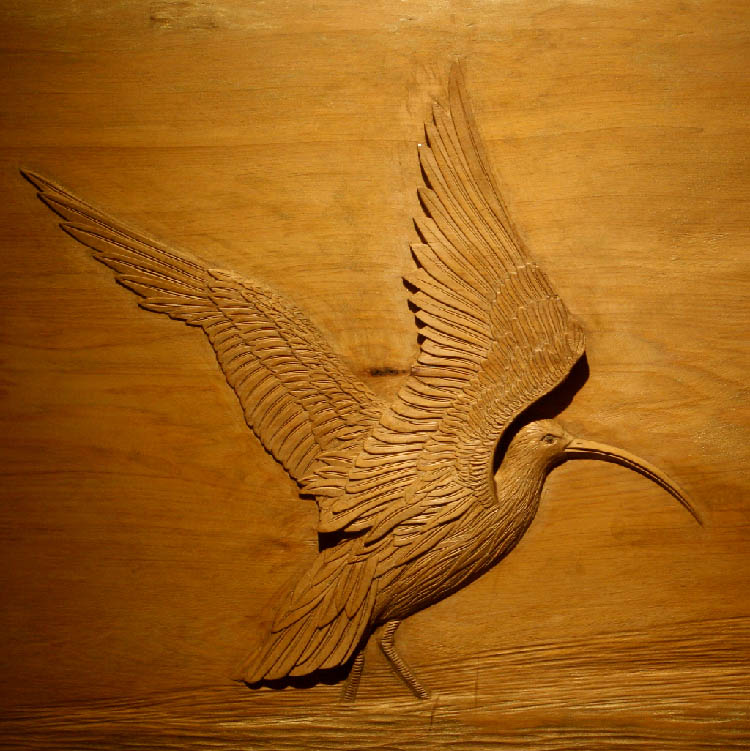
| Bird
|
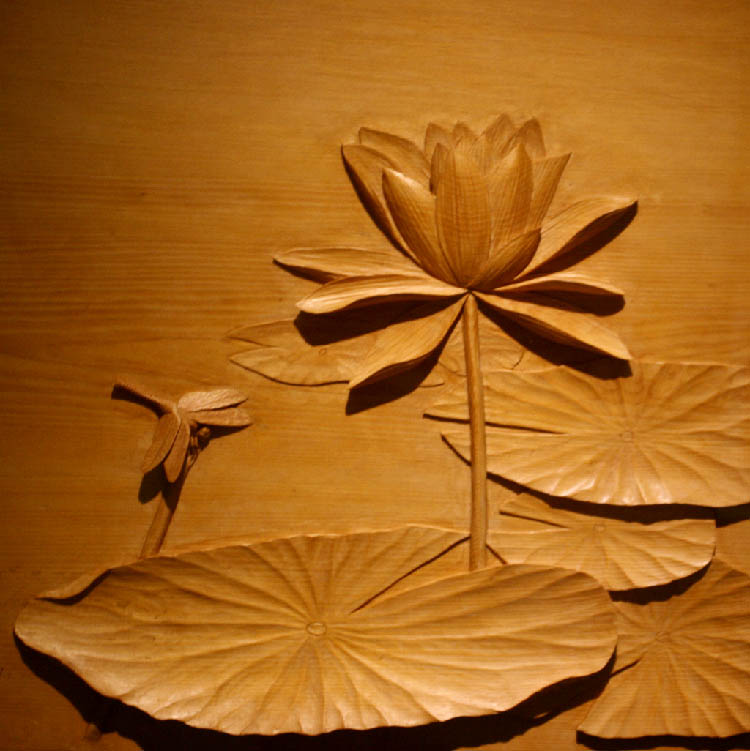
| Lotus
|
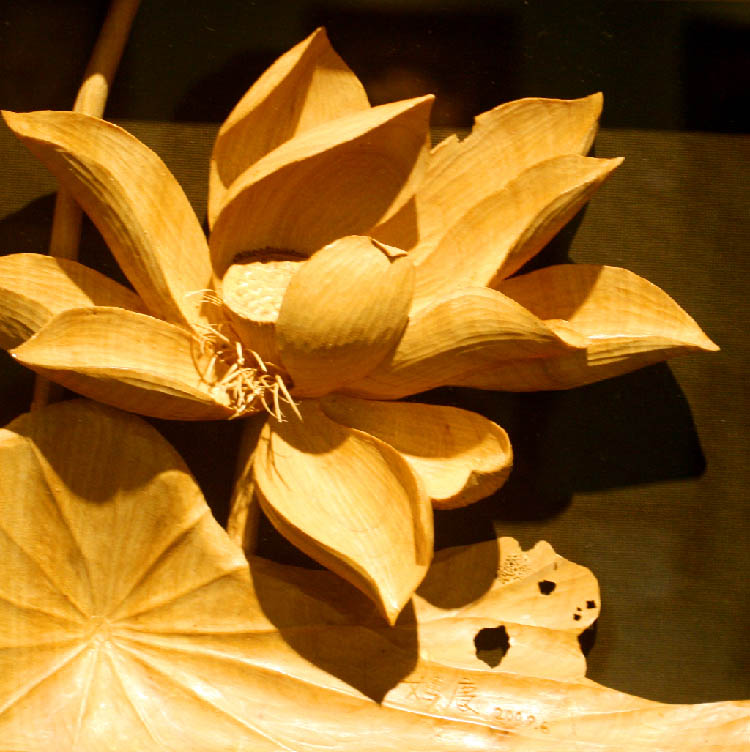
| Blossom
|
The Chiang Kai-shek Memorial Hall is surrounded by a beautiful park, or better garden, with many nicely cut trees and flowers. Chang is looking from his throne in the direction to Mainland China in the east, where he always wanted to come back to (and rule there again, of course).
You can't see China, but you can see the largest monumental archway in Taiwan, now called the Liberty Square, at the end of the Democracy Boulevard flanked by the National Theater on the left and the National Concert Hall on the right.
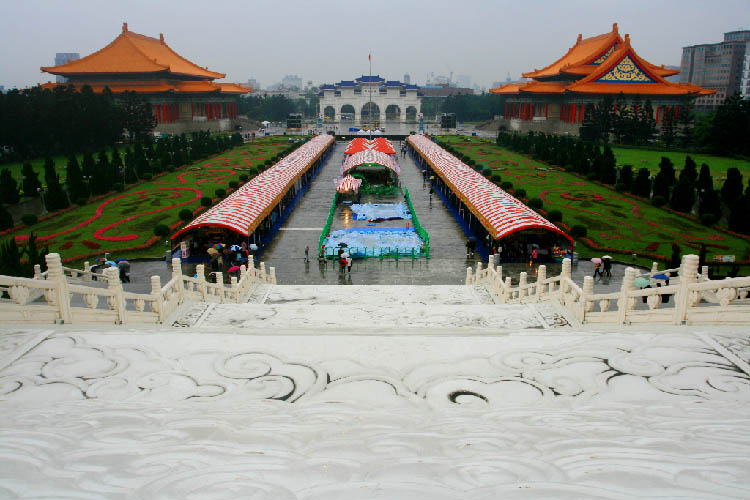
| Outside again, still raining
|
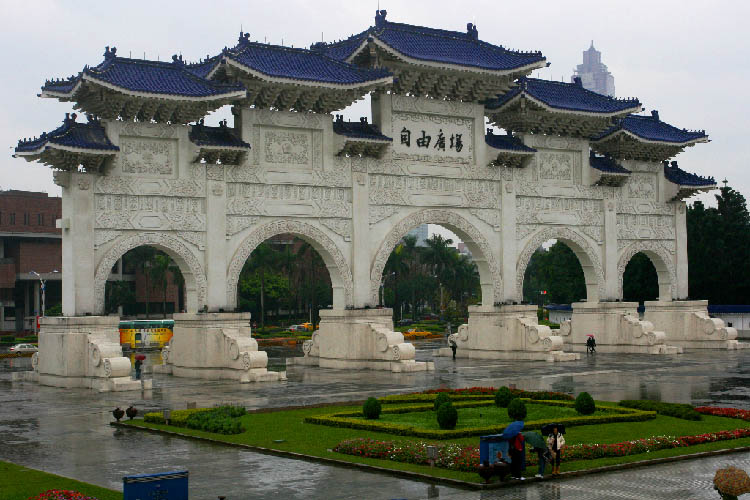
| with that nice gate at the end
|
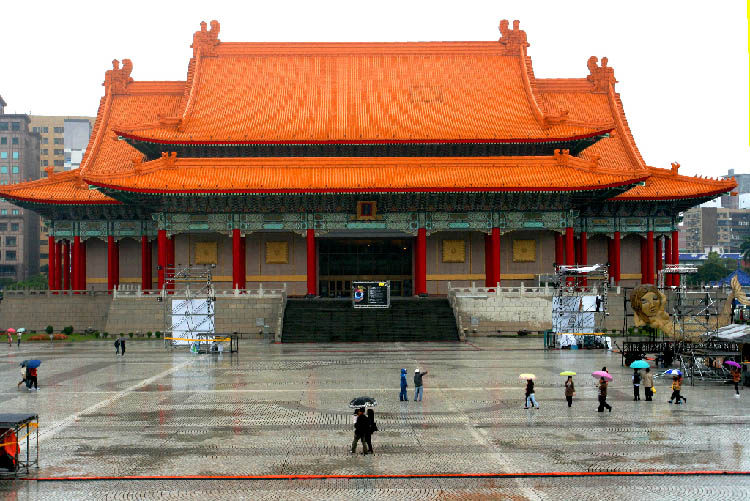
| This is the National Concert Hall
|
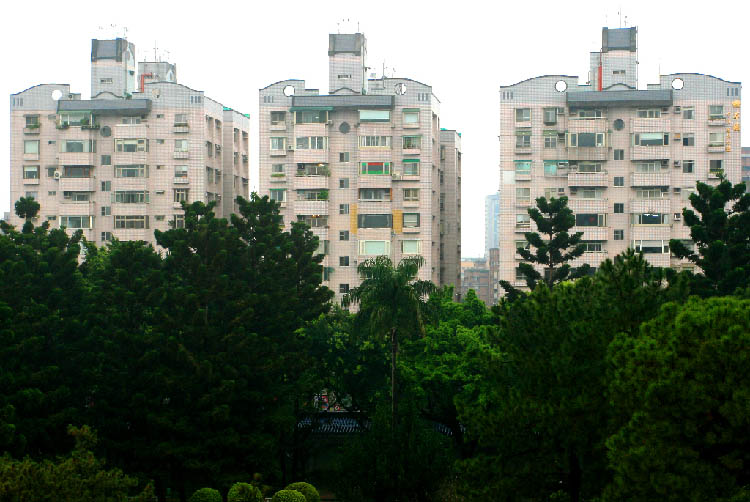
| and these are some condo buildings
|
And then, what a surprise, another exhibition, but not in Chang's but in a subway's underground passage tunnel "gallery" of the Chiang Kai-shek Memorial Hall MRT station. I didn't only like the beautiful girls but more so all the different folklore costumes they are dressed in and their hairdos. It's a pity that I couldn't meet them in real.
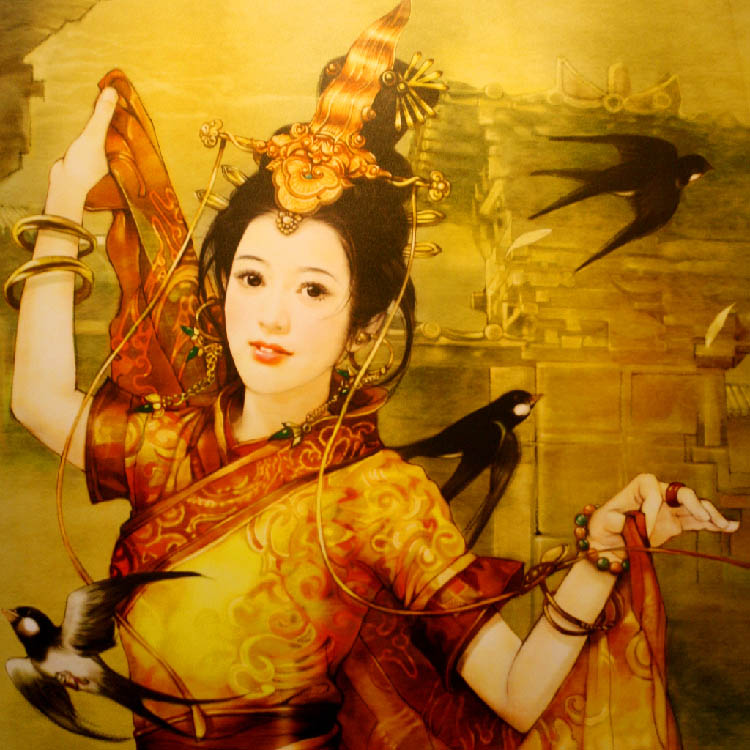
| Girls
|
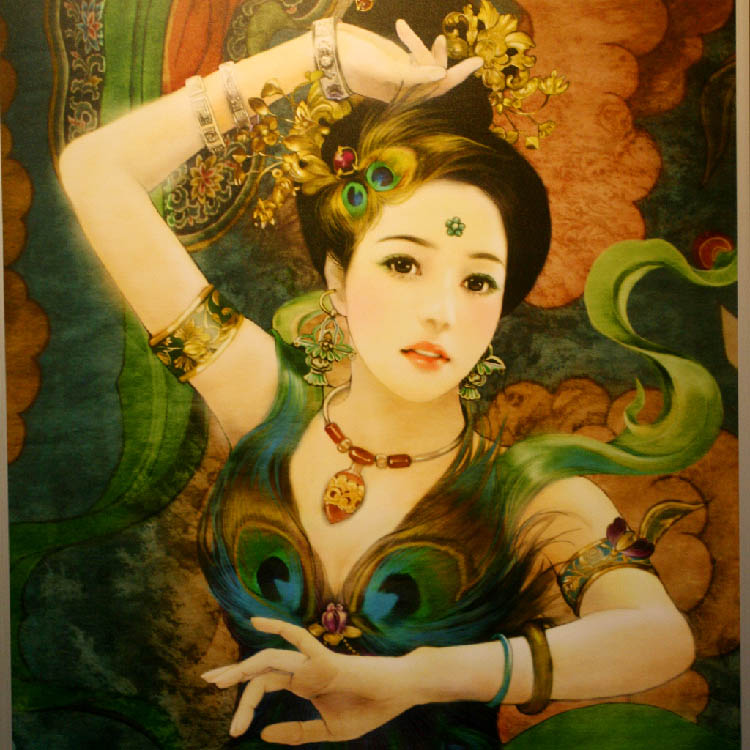
| Girls
|
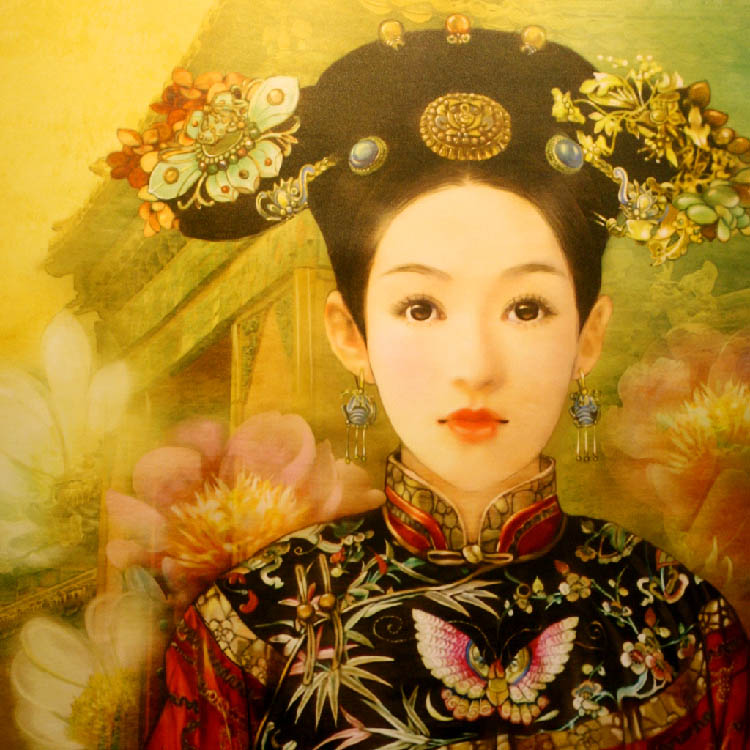
| Girls
|
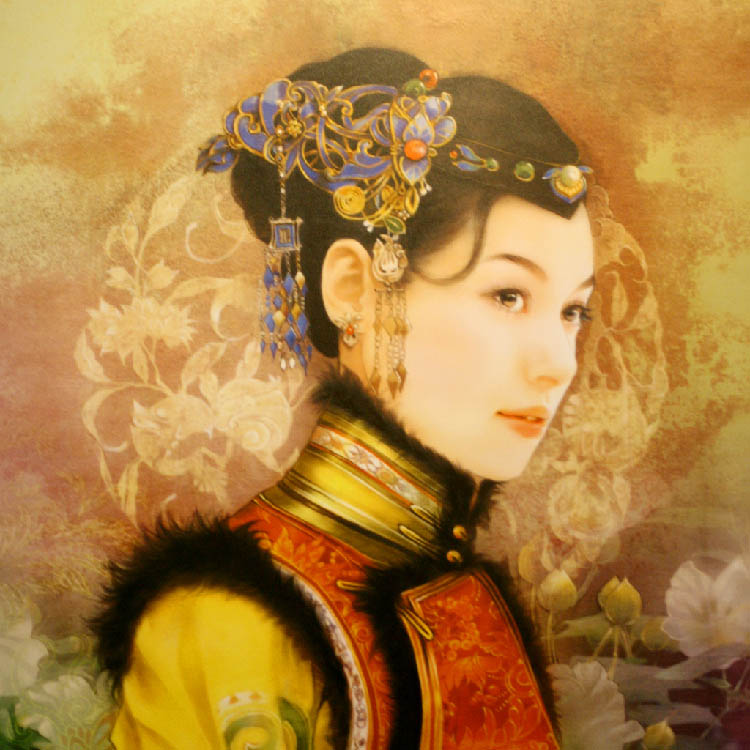
| Girls
|
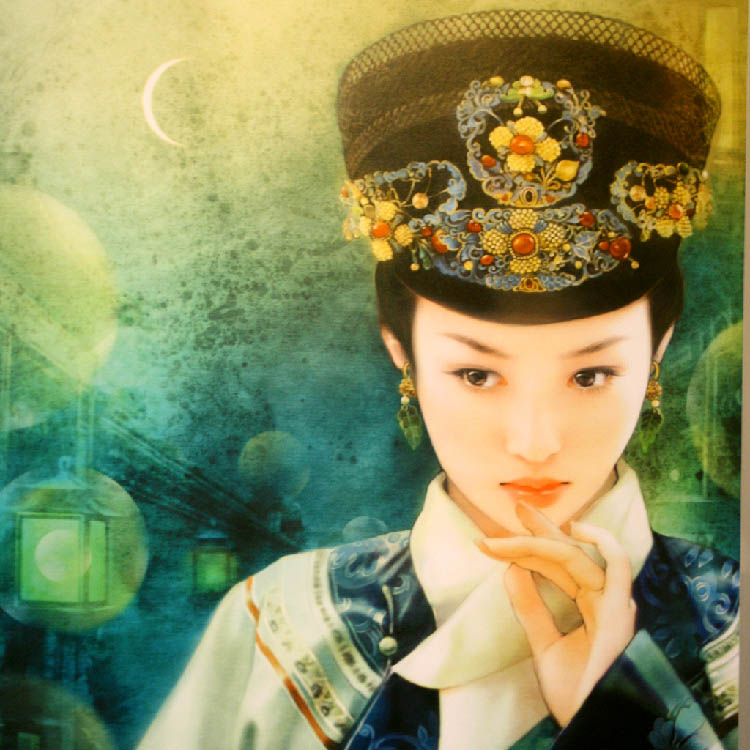
| Girls
|
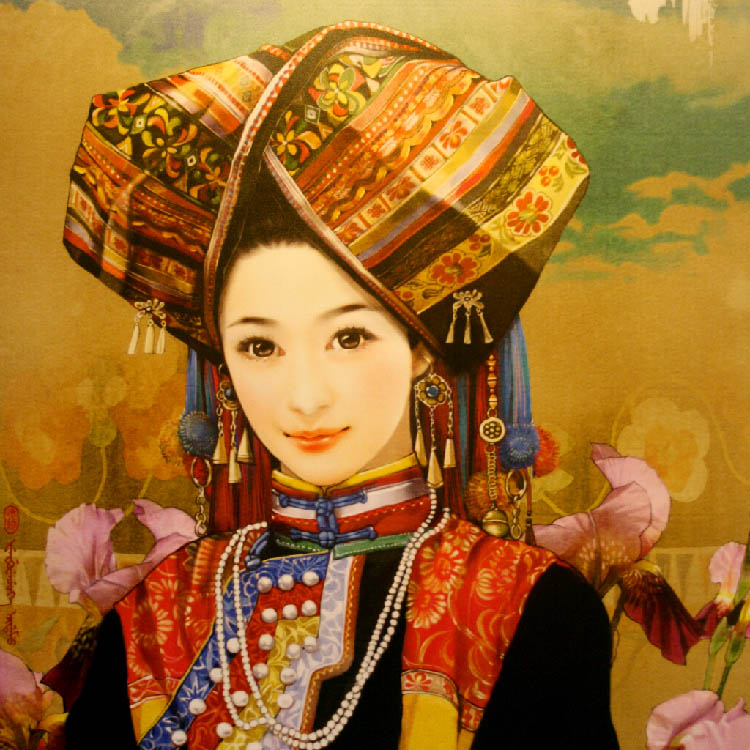
| Girls
|
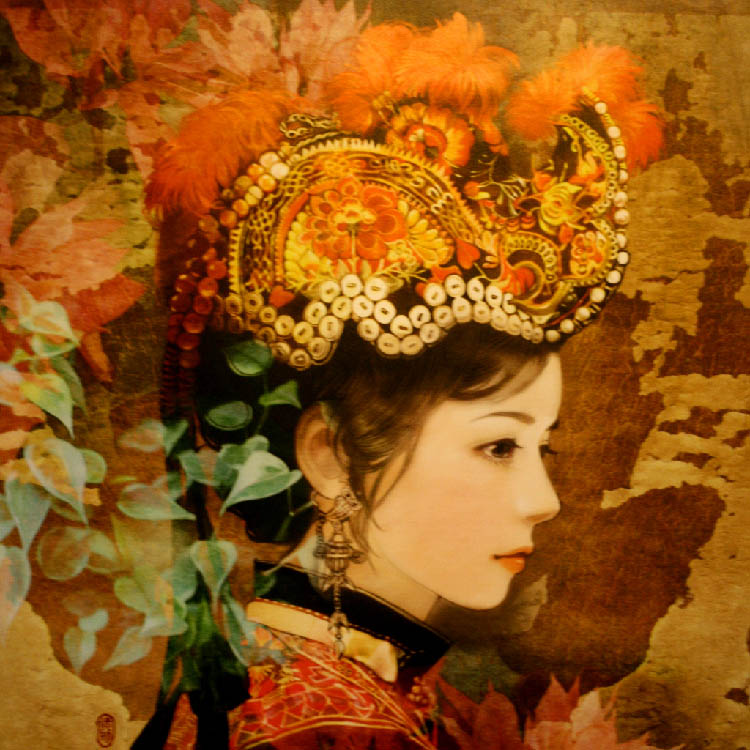
| Girls
|
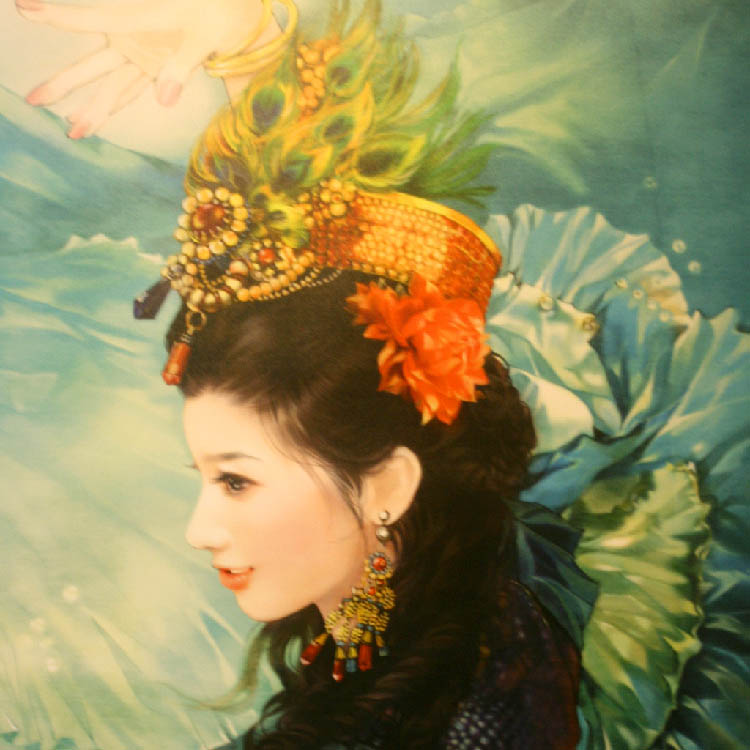
| Girls
|
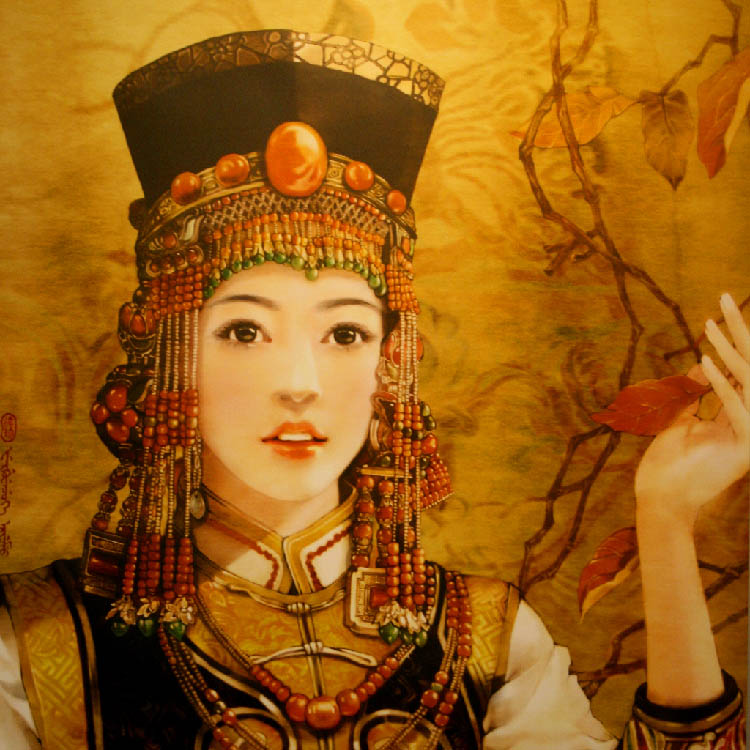
| Girls
|
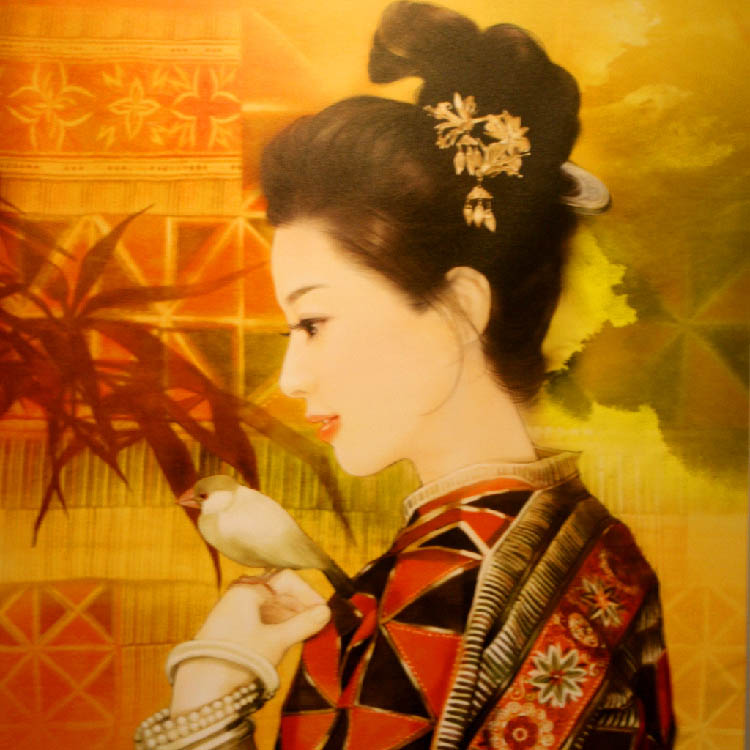
| Girls
|
The Martyrs' Shrine
After the changing of the guard at the Chiang Kai-shek Memorial Hall I wanted to see another one at the National Revolutionary Martyrs' Shrine. This place enshrines the dead of the wars fought on behalf of the Republic of China, whether against the Japanese, the Communist Chinese or who else. The main building is modeled after the Taiho Palace in Beijing with friezes around describing the various battles.
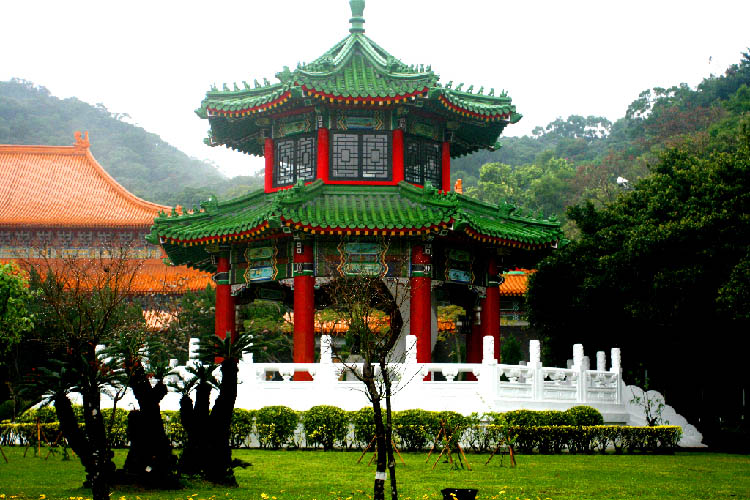
| Another temple complex?
|
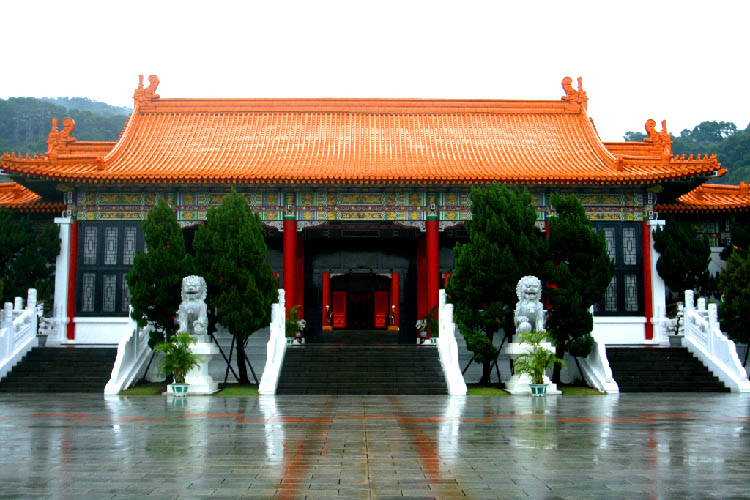
| Better: a martyr's monument
|
And then again: on the hour, every hour: Changing of the Guard. And here you can try to march with them from the Shrine to the gate.
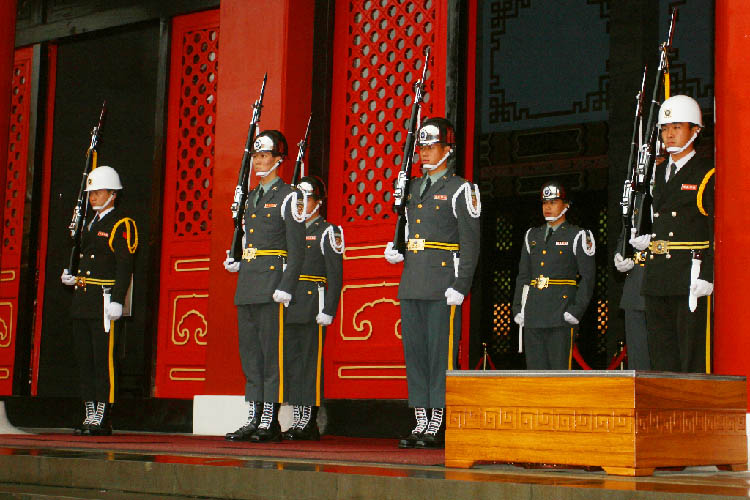
| Another changing
|
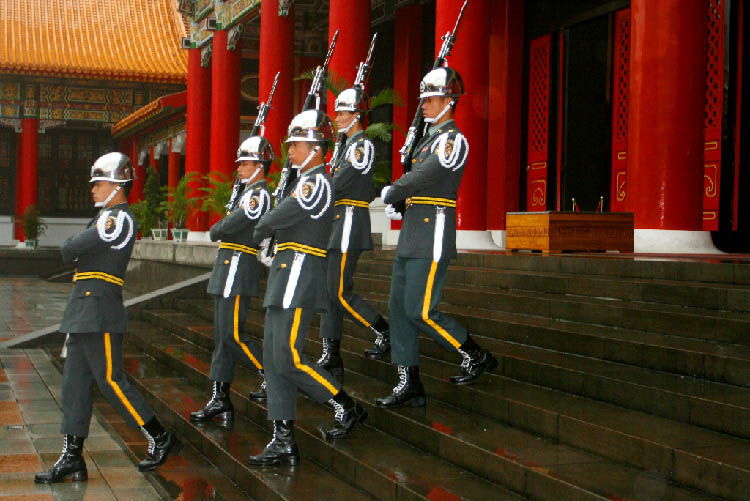
| of the guard
|
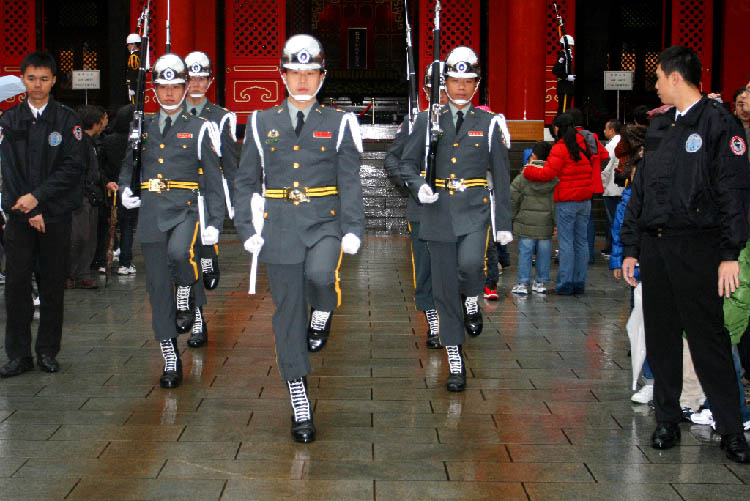
| Old guard
|
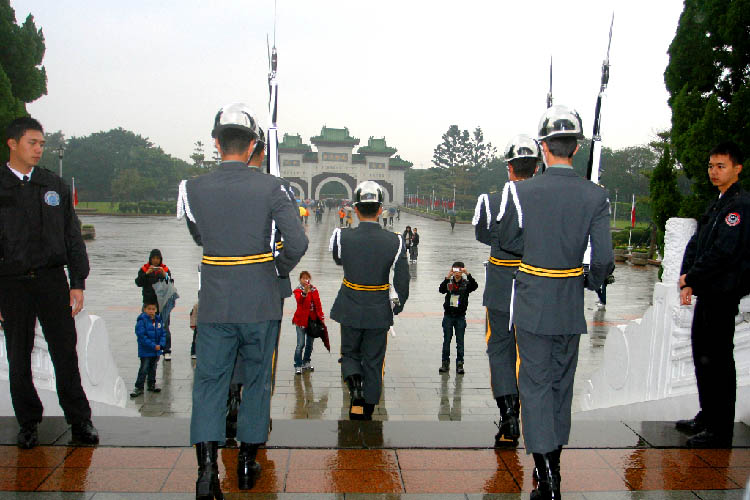
| Good Bye
|
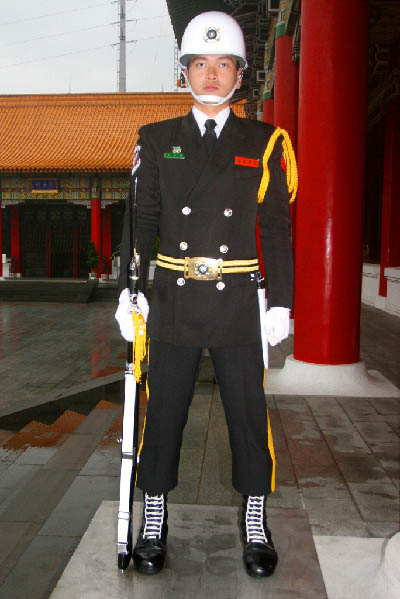
| New guard left
|
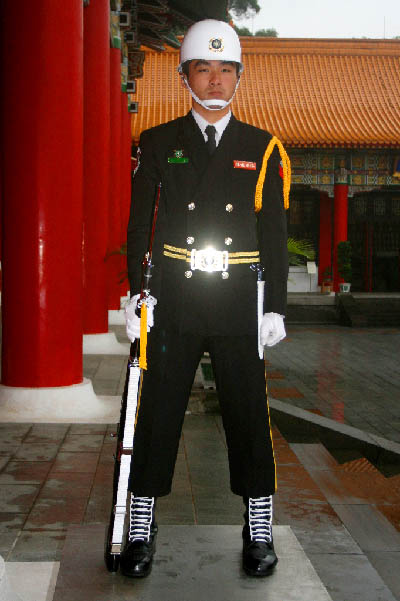
| New guard right
|
How to get to the Martyr's Shrine? It's a 15 minutes walk from the Grand Hotel (but better ask for direction before you start). How to get to the Grand Hotel in the first place if you can't afford to stay there: Take the subway to the Jiantan MRT station and walk from there also around 15 minutes back under the track until you see the remarkable Grand Hotel and then it's easy to walk up the hill to reach the backside entrance.
Ok, you could have joined a sight-seeing tour or taken a taxi. I always prefer to get around with public transport and walk on my own to hit some unexpected places I otherwise would not have seen.
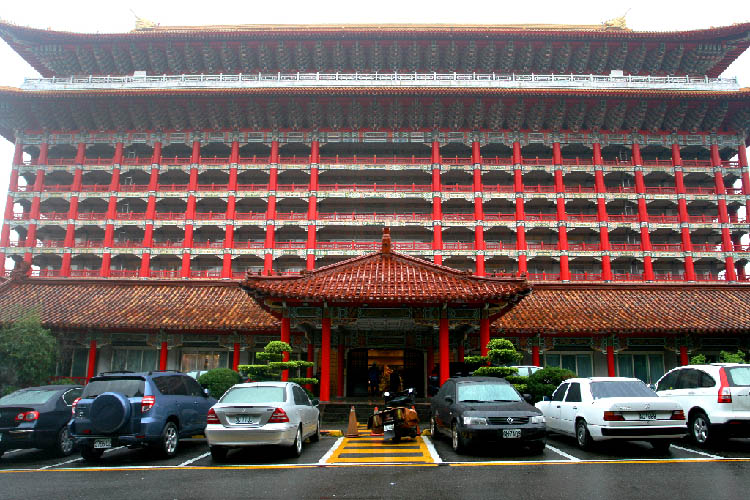
| Grand Hotel
|
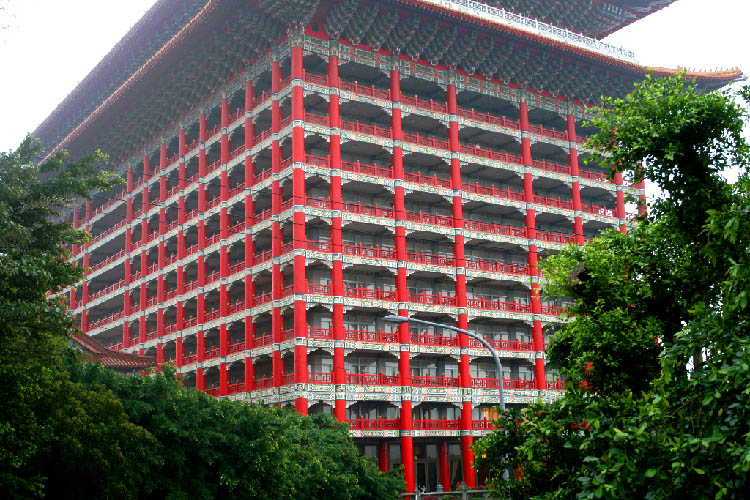
| Chinese Style
|
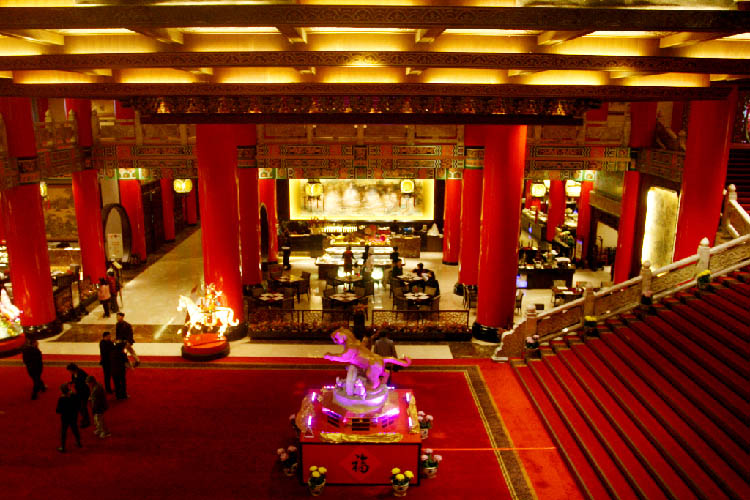
| Lobby
|
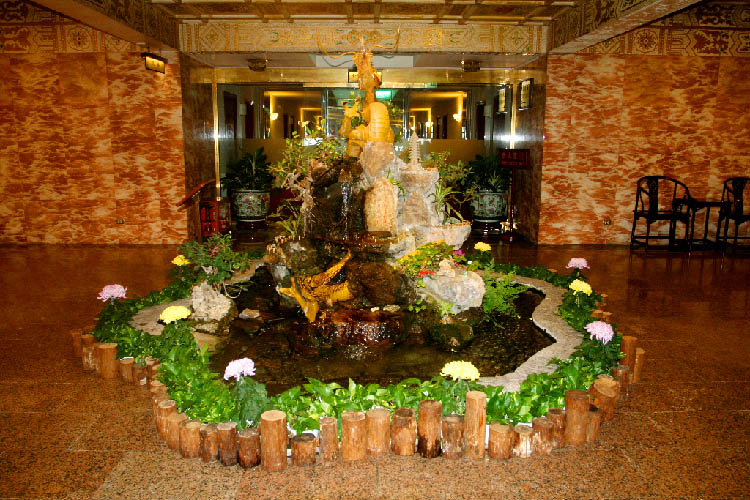
| Fountain
|
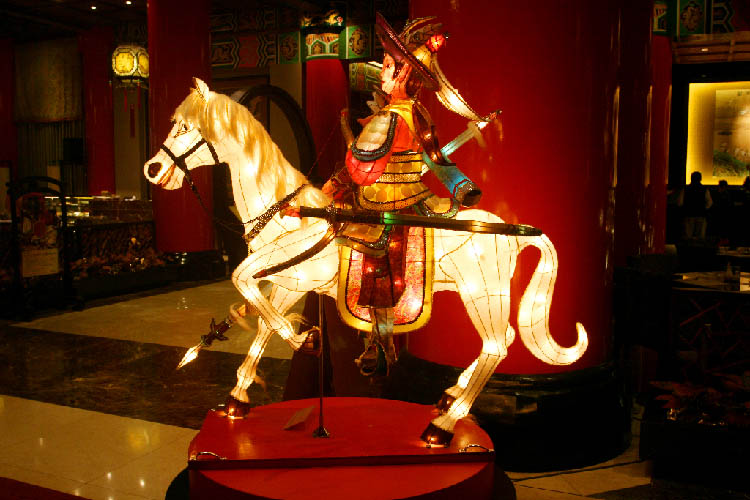
| Glas Art
|
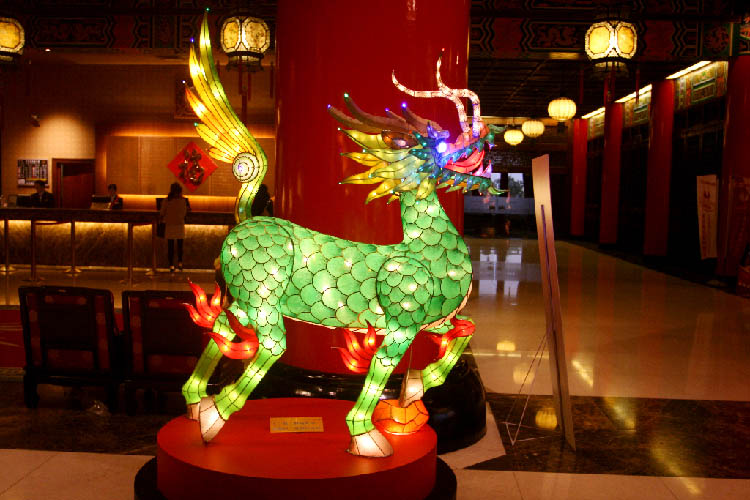
| Decoration
|
Only a big spender can afford to stay in such a splendor. If I would have enough money to spare then this is the place I would prefer. Maybe I should also get a lot of spirit money to burn so I can get someday real money in return. It's common sense that nobody can get rich by working with their own hands. But rather by believing in good luck and praying for it and betting at the stock exchange.
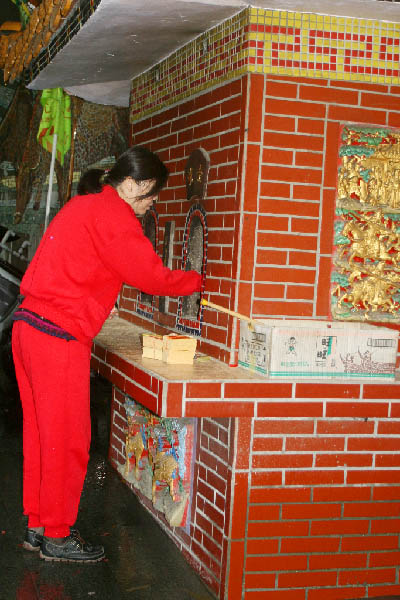
| A place to burn spirit money
|
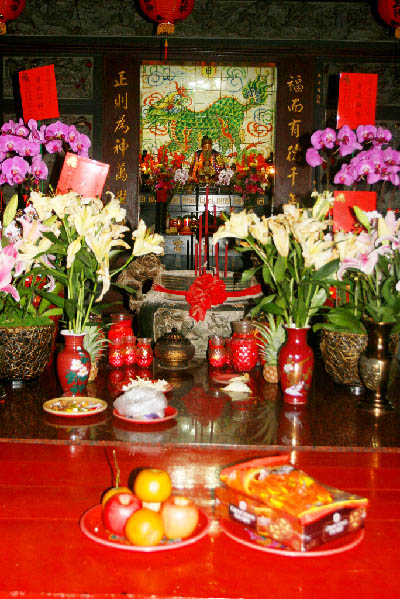
| next to the altar to pray for more of the real one
|
Ok, that's it. I know that I have missed a lot. Especially visiting all the museums, in particular the National Palace Museum. This, of course, I will reserve for another rainy stay in Taipei, someday.
So, Taiwan, in general, has a lot more to offer and if you want to know more, then just look up any guidebook or the internet. To summarize it I would say the trip to Taipei was really worth it. Even if Taiwan seems to be a small island, but there is a lot more to see. Next time, maybe.
| 




















































































































